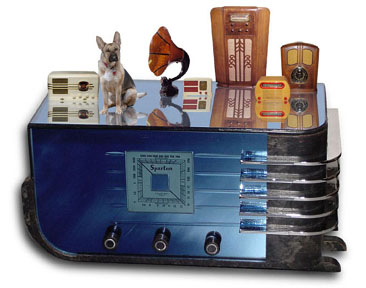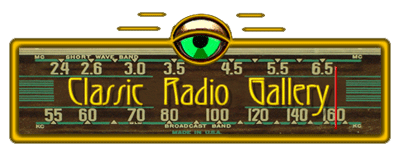
presents:
The History of FADA Radios

Frank Angelo D'Andrea (born 1888, Salerno, Italy {1}) was the creator of FADA Radios.
The D'Andreas' recently widowed mother moved the family to New York in 1890 when Frank was 18 months old.
At age 11, he had to leave school and go to work, but spent his nights studying drafting and mathematics.
Frank's youth endeavors included a newspaper boy, stable boy and boxer.
He left all this behind when in 1913 he graduated from an engineering course,
and began working for the Frederick Pierce Co. doing experimental work for inventors.
Guglielmo Marconi came to the lab one day and had Frank work on a radio apparatus for him.
Shortly after this meeting, Frank left the Pierce lab and began a job with Dr. Lee De Forest, inventor of the audion tube.
Frank worked with De Forest as the first voice was broadcast using De Forest's tube.
Frank soon became a plant manager for the De Forest company.
In 1918, Frank Andrea went into business for himself, with his 16-year-old half brother.
They rented space in a Bronx butcher shop to begin production of crystal radio parts and kits.
He married his childhood sweetheart Concetta Ambrose.{1}
For the name of his company he adopted his initials: F.A.D.A.
When the radio boom hit in late 1921, FADA couldn't produce crystal detectors fast enough,
and soon was renting space in three different places on the same street, Jerome Ave. in the Bronx.
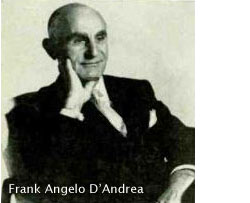
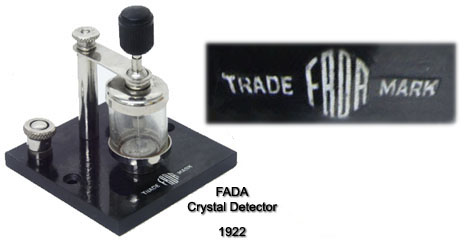
Frank's brilliant foresight recognized that crystal radios would be replaced by tube radios and around 1923,
FADA started manufacturing vacuum tube radios which were well accepted by the public and experienced a rapid growth.
FADA licensed the Neutrodyne radio technology from the Hazeltine Corporation.
In 1925, Frank expanded marketing to Canada and the UK.
Fada's catalog included Fada-branded radio components and vacuum tubes,
sold separately for the home radio experimenter.
1925 FADA radio models


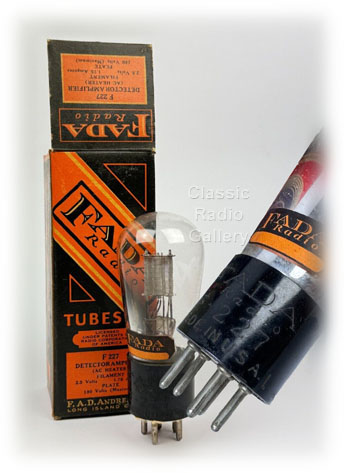
Apparently Frank Andrea's employer-employee relationships were very poor,
and in 1926, 500 of his 600 employees went on strike.
In 1927, his chief engineer, Lewis Clement, left for a better offer with another company.
Soon after, his second in command of the company, Dick Klein, had quarreled with D'Andrea and left also.
Despite these issues Fada continued to grow quickly
moving from their 1581 Jerome Ave factory in the Bronx
to Jackson Ave, Orchard and Queens Streets in Long Island City in 1927,
with 3 times the manufacturing space.
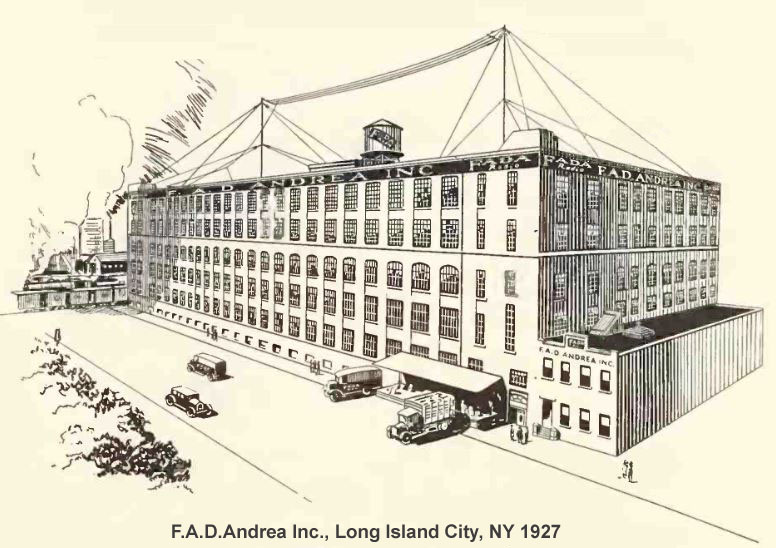
In 1928 FADA's status was in the top five of radio manufacturing companies.
In the early '30s, FADA even joined into the home appliance market
like other radio manufacturers such as Sparton and Crosley were doing,
with a full line of refrigerators and a "wireless" iron (see the ads below).
It was likely an attempt to offset the drastic drop in radio sales after the stock market crash.
The crash eventually took its toll and in 1932 Frank sold
his trademarks and patents as the "FADA Radio & Electric Co." to a group of Boston businessmen.
The new owners filed for bankruptcy shortly thereafter in 1934
followed by a rescue and recovery in 1935 by a group of New York investers, led by Jacob M. Marks.
JM Marks acted as FADA's GM, then as president
until the final days of the FADA Radio & Electric Co. in 1955.

Frank A.D. Andrea retired after the sale in 1932 quite wealthy,
but after 2 idle years, Frank decided he wasn't ready to stop,
and in 1934, Frank re-established F.A.D. Andrea Inc.
His new $10,000 investment grew into a 2nd fortune.{1}
F.A.D. Andrea Inc. began marketing radios in direct competition with
the newly resurrected FADA Radio & Electric Co. now under new ownership.
The "FADA" trademark was sold, so F.A.D. Andrea Inc. now began
selling radios bearing the "Andrea" name.
Although successful, F.A.D. Andrea Inc. never reached the status
of the new FADA Radio & Electric Company's sales.
(Frank's new factory after re-establishing F.A.D. Andrea Inc.)
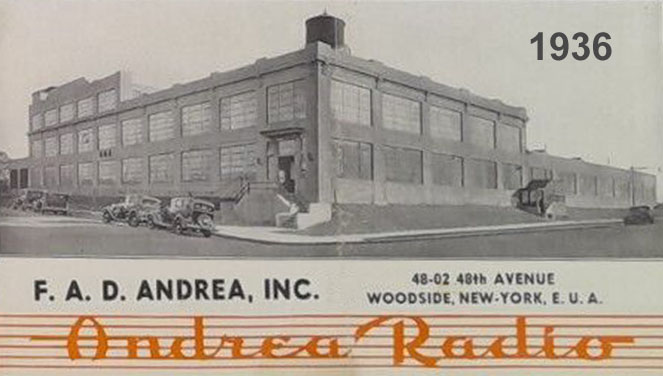
FADA and Andrea radios around the world
The FADA radio name had became well known world-wide by the 1930s.A mid '30s F.A.D. Andrea Inc. radio brochure from Paris reveals that after FADA was sold,
Frank was still capitalizing on the FADA name, boldly using his initials in Andrea Radio ads.
1930s advertising show active marketing for both FADA and Andrea radios in Italy and France.
In the early '30s SIARE, Piacenza was granted a license to manufacture and distribute FADA radios in Italy.
SIARE, Piacenza also produced Crosley radios in Italy with a similar license arrangement.
This was a common practice in the '30s, easing the need to export as many radios,
eliminating customs fees and helping to keep the radios more affordable.
Other radio manufacturers such as Sonora and Pilot Radio also produced radios in Europe.
Some models were similar to the US-made models and others were unique designs.
Both Fada and Pilot radio designs have surfaced in Australian radio models as well.
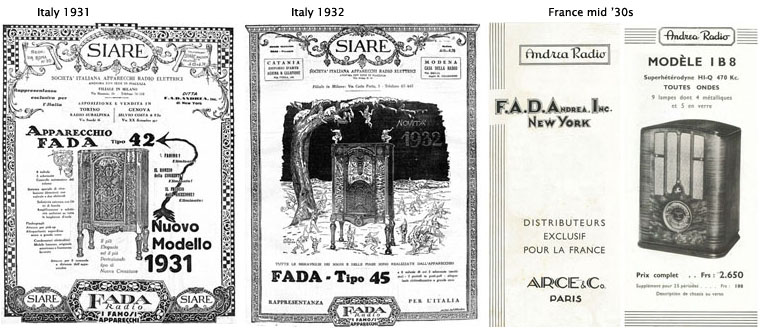
These two unique designs are 1930s FADA radios found in South America,
possibly made in South America under license, as was done in Italy.
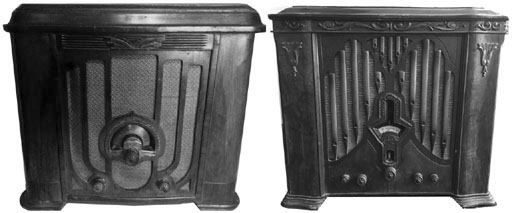
Although many of FADA's export designs are not found in the US,
some of the popular US models have been found with European dial markings.

(hover/tap for a closer look)

In 1937 F.A.D. Andrea Inc. officially changed its corporate title to Andrea Radio Corp.
1938 Andrea Radio advertising list their address at 4820 48th Ave, Woodside, Long Island, New York.
Shortly after, in 1938, Andrea Radio Corp began television production, and in 1939
displayed their new television model at the New York World's Fair.
As with every radio manufacturer, Andrea consumer tv and radio production was suspended as WWII began,
and in 1942 all resources shifted to the production of military electronics to aid the war effort.
In 1946, following WWII, consumer manufacturing resumed and Andrea Radio
again offered new yearly line-ups of radio and television models.
1950 advertising list the address as 27-01 Bridge Plaza North, Long Island City, New York.
Frank continued running the company until his death at the age of 77 (Dec 22, 1965).
His business was continued by his son F.A.D. Andrea, Jr., and his daughter Camille.
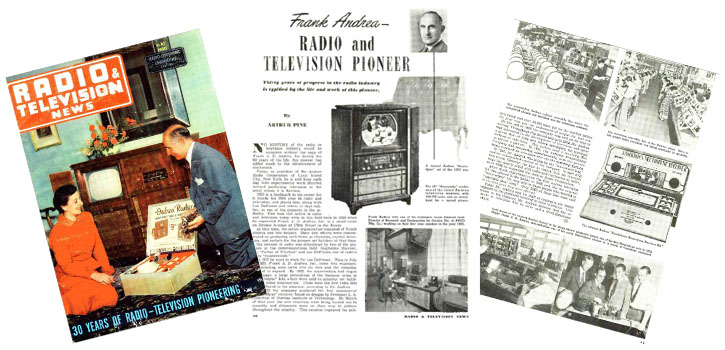
Frank and his daughter, Camille on the cover of Radio & Television News, May 1950.
"No history of the radio or television industry would be complete
without the saga of Frank A.D. Andrea..."

In 1961 Andrea became a public corporation now trading under the ticker symbol ANDR.
During the 1970s and '80s, Andrea was a big supplier for Boeing, Lockheed and others.
In 1990 the name was officially changed from Andrea Radio to Andrea Electronics Corp.{2}



The new FADA Radio & Electric Company, 1935
FADA gears back up in 1935 under new direction and leadership,revived as the FADA Radio & Electric Co., Inc.
New owners purchased a factory site at 30-20 Thompson Ave., Long Island City, NY.
J.M. Marks took over the helm and never minced words about its position in the radio industry,
"...our company is the original Fada Company and controls all the rights and trade-marks, patents, etc.,
dating from its inception since 1921; and that the firm of F.A.D.Andrea Inc., selling Andrea Radios,
outside of the fact that Frank Andrea is the head of the company, has no more relationship
to our trade-mark (Fada) than Mr. DuPont has to the General Motors Co., with which he
was importantly affiliated at the time of its inception.
Our company is a bonafide licensee of RCA as well as Hazeltine." (Radio Today, June 1937)
Marks was a great marketer and played a big role in the push for retail promotions and
encouraged radio cabinets with bright colors.
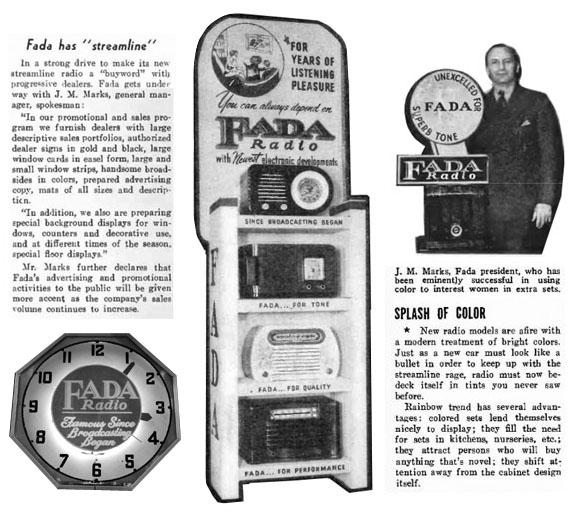
The re-established FADA was an early success.
FADA's "Coloradio" and "Fadalette" lines in 1936-37 radios sold well.
The radios were made with colorful plastics, some with chrome or gold trim.
FADA produced what have become some of today's most sought after radios.
Some designs were so popular that they were shared with, or "borrowed" by other radio makers.
In 1938, a couple years after the Coloradio line was released,
Australian radio maker "Hotpoint" issued the "Bandmaster" model with a nearly identical cabinet.
Other than the dial and knobs, every other design line was copied.
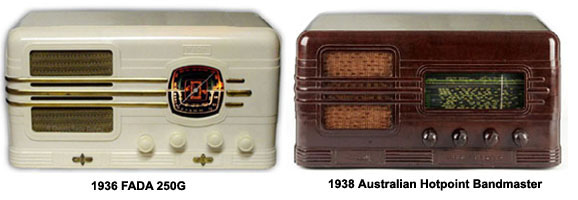
In 1941, Fada's president JM Marks recruited well-known radio pioneer McMurdo Silver.
McMurdo Silver radios of the 1930s were beautiful high-end, chrome plated radios.
In 1938 Silver had sold out the remainder of his company to his competitor, E.H. Scott Radio Laboratories.
He was appointed as vice-president of FADA's Special Equipment Division,
handling commercial and National Defense radio production.
Radio Today, July 1941
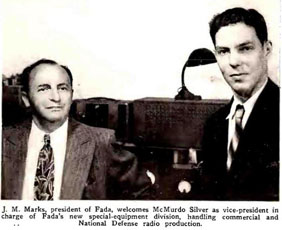
In 1942 when World War II began, consumer radio production
was halted at all factories mandated by the government.
All factory resources were focused on the contribution to the war effort.
FADA production shifted to equipment made only for military use from 1942-1945.
This oscilloscope was made by FADA for the US Navy.
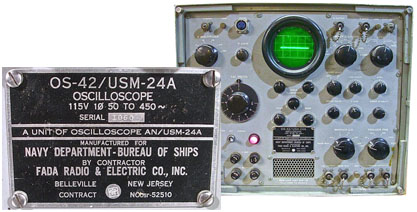
When World War II ended, FADA returned to consumer radio production.
FADA picked up where they left off, continuing sales of the popular catalin FADA "Bullet".
Before the war they were sold as the model 115, issued now as the model 1000.
Other radio cabinet molds were also revived after the war
with updated circuitry and newly assigned model numbers.
Many of the radios that Fada produced in the late '30s and '40s are highly prized by radio collectors.
Today, the FADA model 115 or 1000 "Bullet" radio has become a true icon in design history.
There is no documentation on the designer of this great piece.
Different size reproductions have surfaced over the years,
and the design surfaces frequently from ad graphics to clocks and cookie jars.

Like radio-makers Belmont and Wells-Gardner,
FADA also supplied radios to independent distributors
who displayed their own retail brand names on the radios.
The Fada 659 shortwave version of the classic catalin Fada "Temple"
is found in the Truetone service manuals as the Truetone model D2780.

Some of FADA's bakelite and wood models from the late 1930s were labeled "Co-op", "Lafayette" or "Dictograph".
Dictograph Products Company Inc patented the "Silent Radio Mystic Ear" pillow speaker and sold the idea to FADA
who then incorporated the idea into many different models.
In some instances, a "Dictograph Silent Radio" or "Co-op" metal nameplate was applied over the top of the embossed FADA name.
The Lafayette equivalents of the FADA L96 and L56(bakelite series) models were identical
except that Lafayette had the molds adjusted so their name was embossed in the plastic, in place of the FADA name.

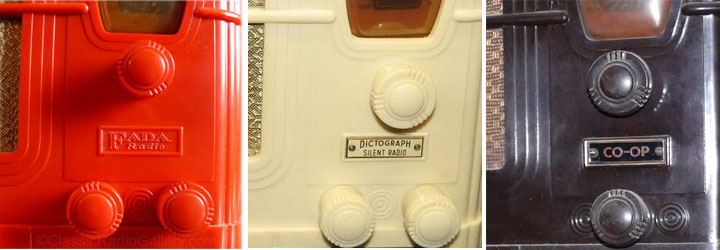
FADA was very resourceful when designing cabinets for various electronic designs.
Many of their radio cabinets, both wood and the bakelite models, were made to house different chassis designs.
AM only, AM/Shortwave, AC/DC, farm battery sets, and other options led to different chassis mounted into identical cabinets.
This explains why so many different FADA model numbers are found on what look like the same radios.
Some cabinet designs accommodated a 2 or a 3 knob chassis with only the knob hole placement shifting,
and still leaving a geometric design in tact as seen above.
Different knob and dial designs were also shared between models.
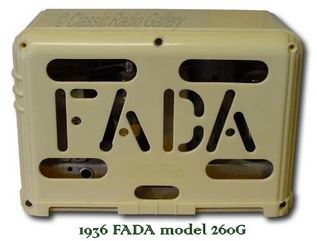

In 1947, Marks announced FADA's expansion and move across the Hudson River
to Belleville, New Jersey into a larger updated plant.
Much of the expansion included space for other electronics including
FADA "Motoset" automobile radios and also televisions for the emerging television market.
FADA branded radios and televisions were successfully marketed into the 1950s.
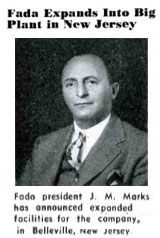
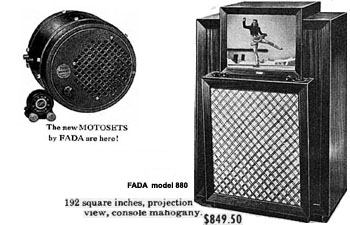
Keeping up with the latest technology, FADA offered a full line of television models and
also introduced an FM-only radio in 1947, the model 795 (shown in an ad below).
The last consumer radios FADA made were in 1955.
An ex FADA distributor emailed me info on a model in the collection,
"This is a model 660. These were the last new radios that FADA produced and were made in 1954 & 1955.
They came in Ebony, Ivory, and Maroon with a gold grille on the Maroon & Ivory, Silver on the Ebony models.
There was a very good looking replacement for the 790 scheduled but they ran out of money before it went into production.
As an ex FADA distributor I saw these items at the plant in 1953/54."
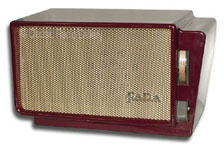

Collecting FADA radios
Today, FADA radios are well-known to collectors
and many are the highlights in any radio collection.
Values of FADA radios differ greatly, with cabinet design the primary driving factor.
FADA radios on todays collectors market can range from $40 to hundreds and even thousands!
FADA made some fabulous wood cabinet floor and table radios that are sometimes overlooked
because the FADA name is so closely associated with their famous plastic models.
Some FADA wood models with high-tube-count designs from the mid '30s are highly sought after,
and can command as much as the expensive catalin models.
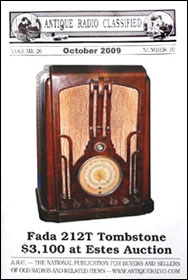
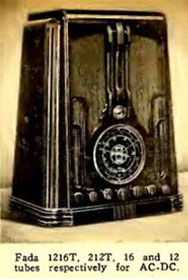
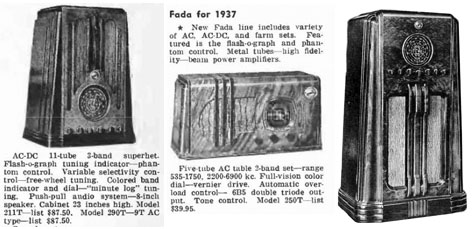
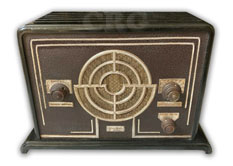
1933 "Century" model 105 (ch.RN)
A few wood versions of the iconic catalin model 115/1000 "bullet" and
252/652/659 "temple" models were also made.
The wood model 252 is one example.
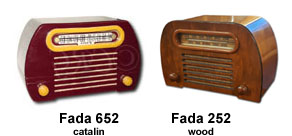

Fada's plastic radio colors and materials is the big factor in their collecting appeal.
The red plaskon "Coloradio" cabinets and any of the catalin cabinets bring the highest prices.
In the mid-'40s, FADA referred to their catalin cabinets as "Fada-lucent".
The Bakelite Corporation referred to all their different plastics as "Bakelite" which have now
been broken down into different categories; bakelite, catalin, plaskon, beetle and styrene by collectors today.
(see our Radio Plastics Explained page that shows the differences between catalin, bakelite and others.)
Although a few of the wood table models were offered with a ivory, ebony or Chinese red laquered cabinet,
FADA never offered any of the plastic radio models with a painted finish. (wood Fada 351JV in ivory)
In the late '40s, FADA began using polystyrene for some radio models,
and although they were able to reproduce the marbling effects,
they did not have the depth and lustrous qualities of catalin.
The blue styrene model 1005
is a treasured addition to any radio collection.
Once you have seen a beautifully marbled catalin radio in person,
you quickly realize why there is the incredible demand for them.
The look and feel of catalin radios it truly unique and unparalleled with their glass-like surface.
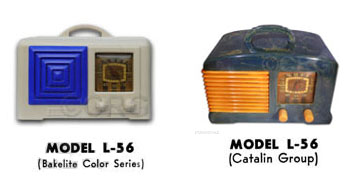
In the case of the Fada model L56 bakelite/plaskon/catalin models;
they are all rare, but the "Bakelite Color Series" radios, although valued less,
are actually more elusive than the catalin versions,
most likely due to the fact that they were introduced at the same time -
and although the plaskon versions are so beautiful,
anyone faced with the choice, would likely have chosen the similarly priced,
fabulously marbled, glass-like qualities of the catalin cabinets over the plaskon versions.
The unfortunate, unforseen shrinkage characteristic of catalin plastics has made
any Fada catalin radio rare to find without damage.
Some Green Jade or Blue Lapis Lazuli catalin examples have sold for over $10K at auction!
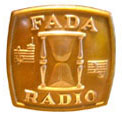

Click on the FADA radio collection below for much more information on each radio and close up photos.
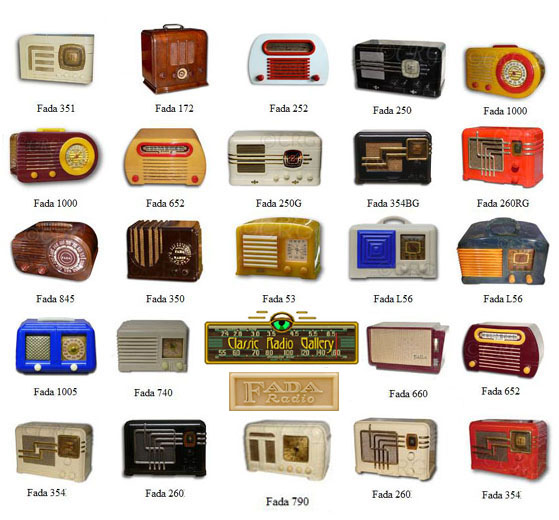
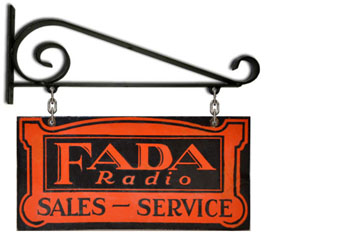
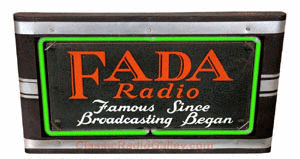
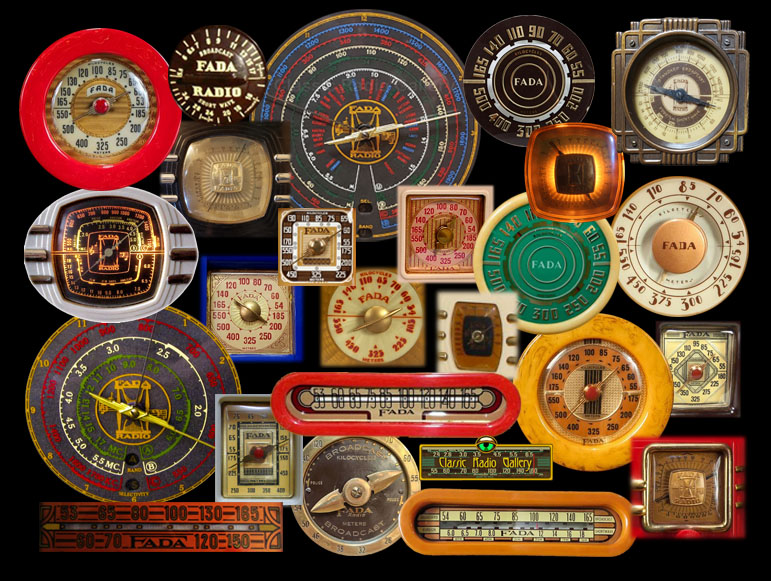
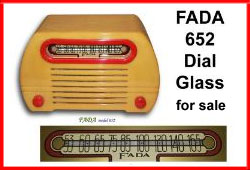
Fada 652 dial glass replacement available
CLICK for details
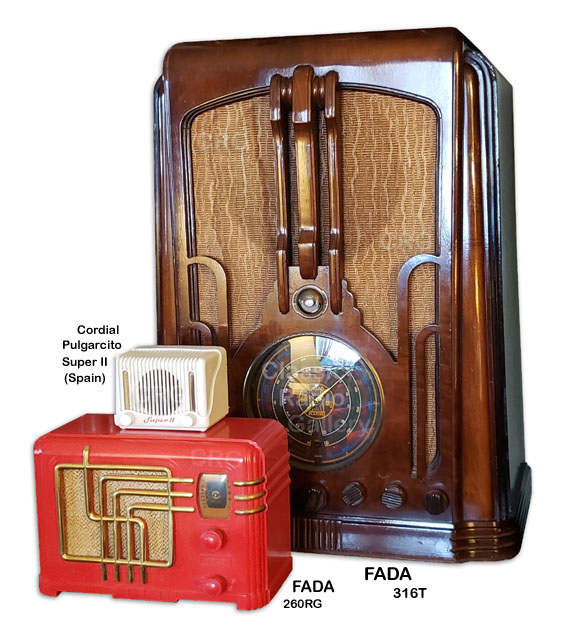
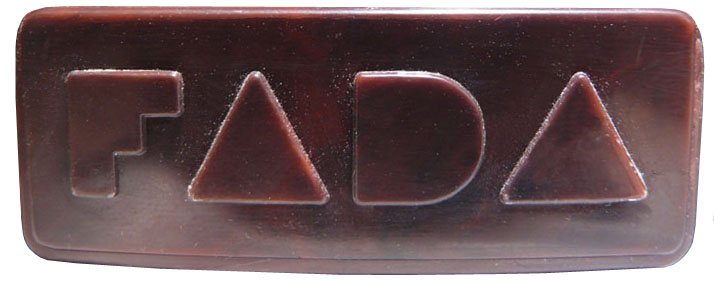
(from the 1950 model 550 or 855)
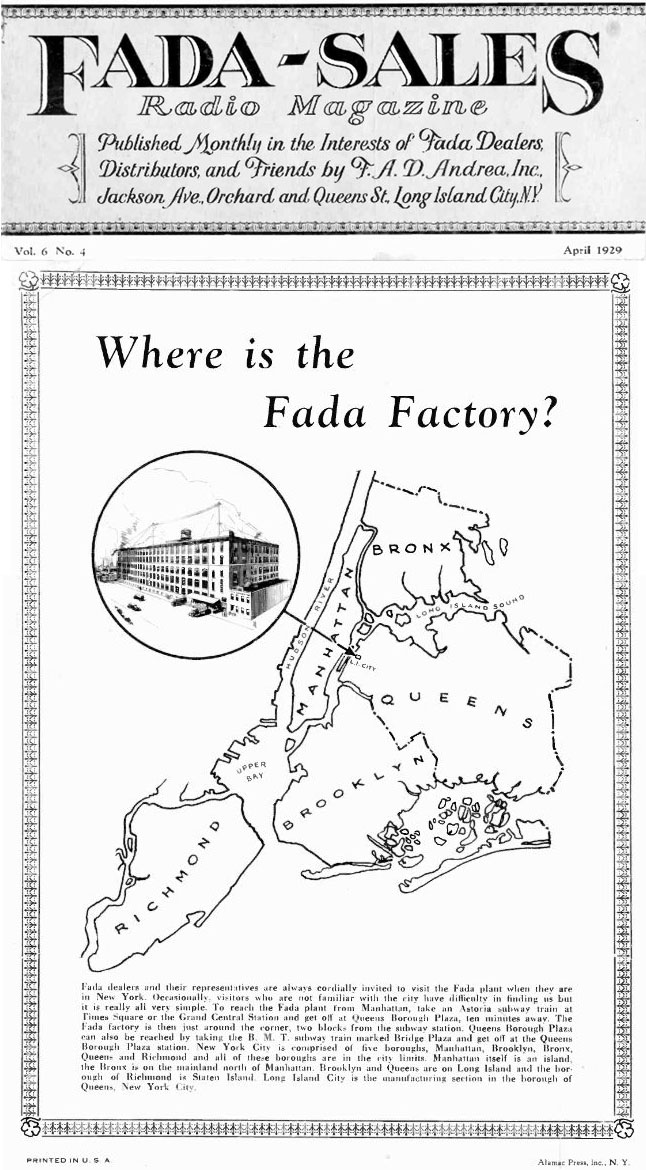
Below are a few interesting articles from the 1930s
regarding the divide between the Fada name and Frank Andrea.
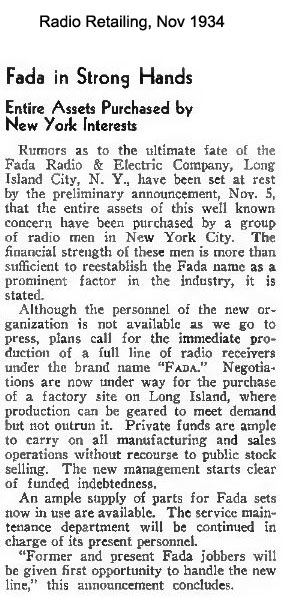
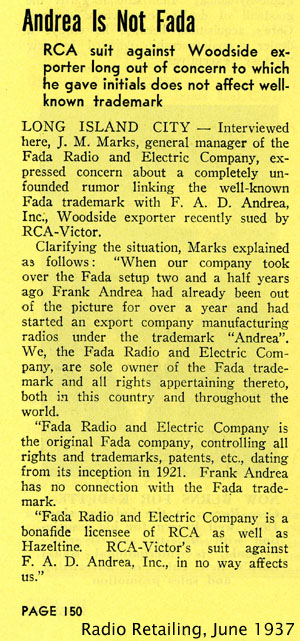
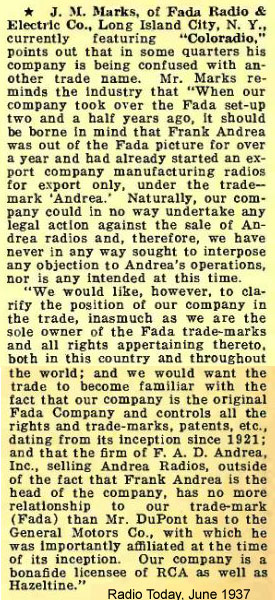
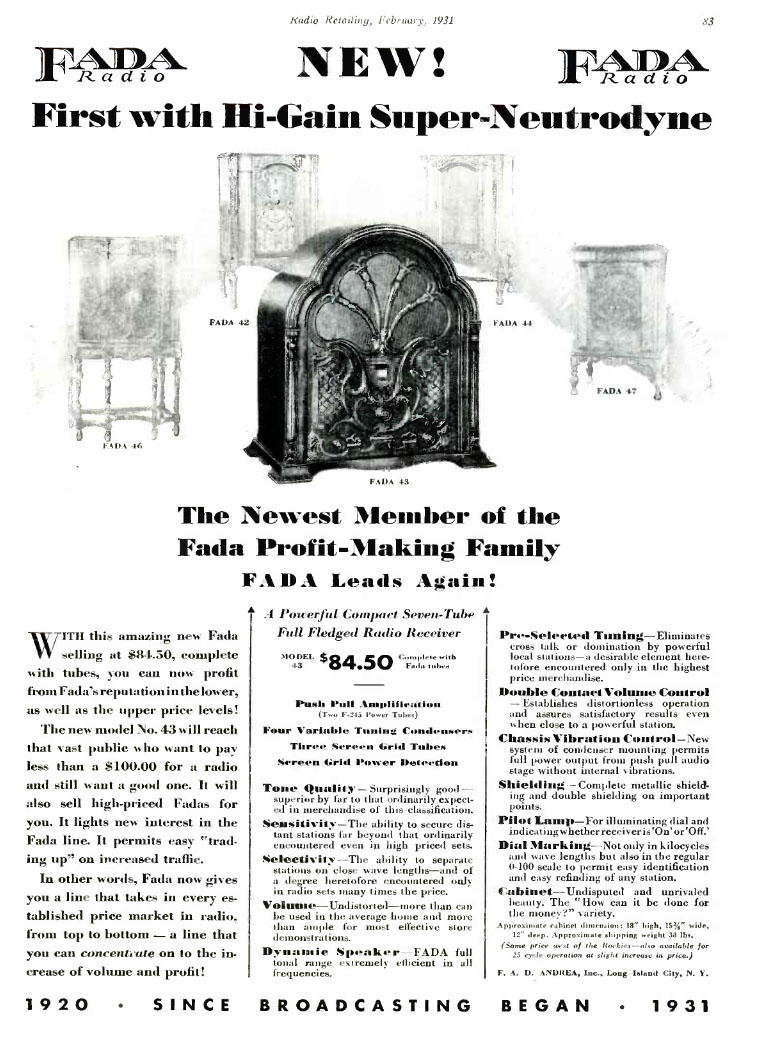
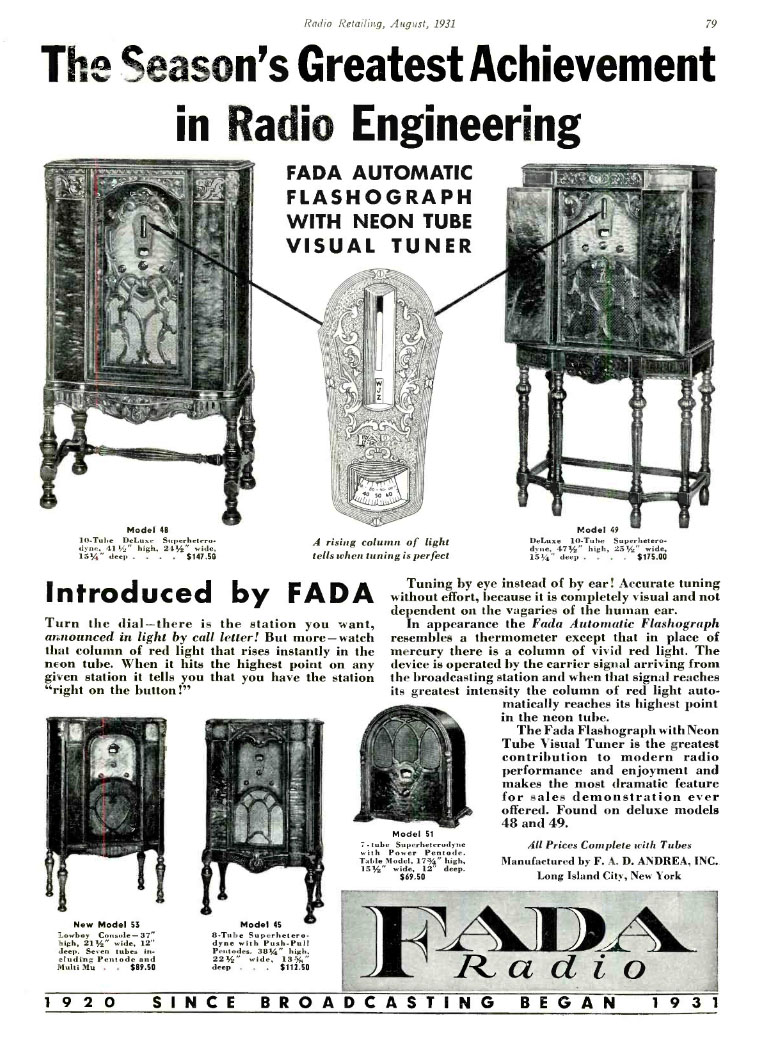
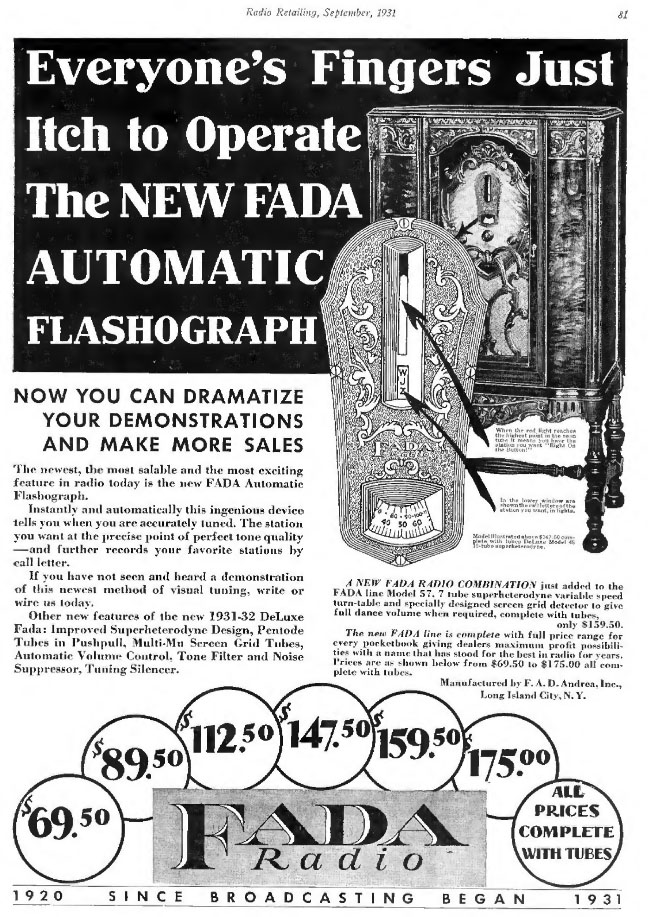
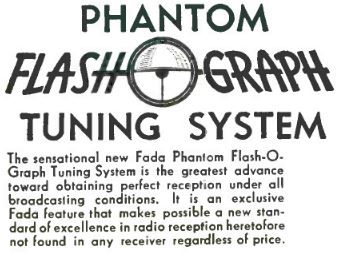
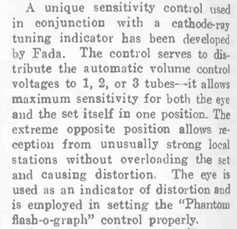
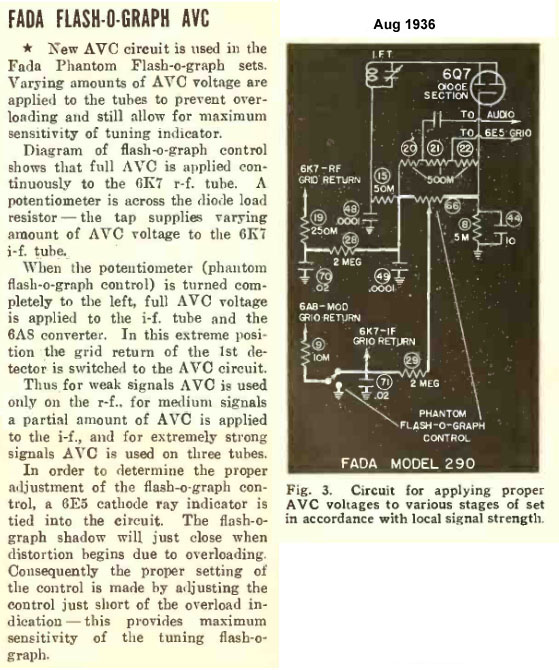
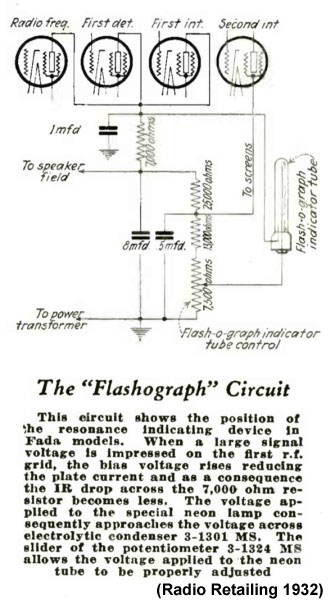
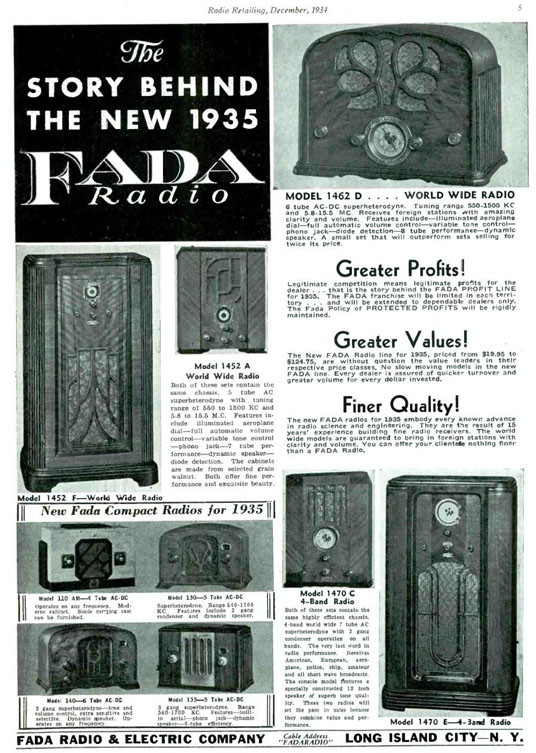

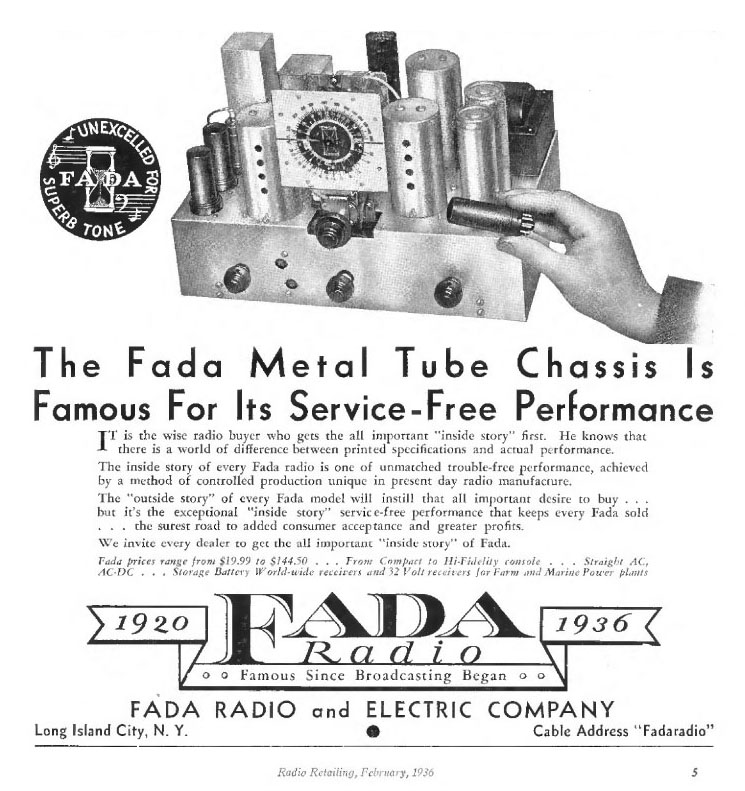
(Aug 1936 Radio Retailing)
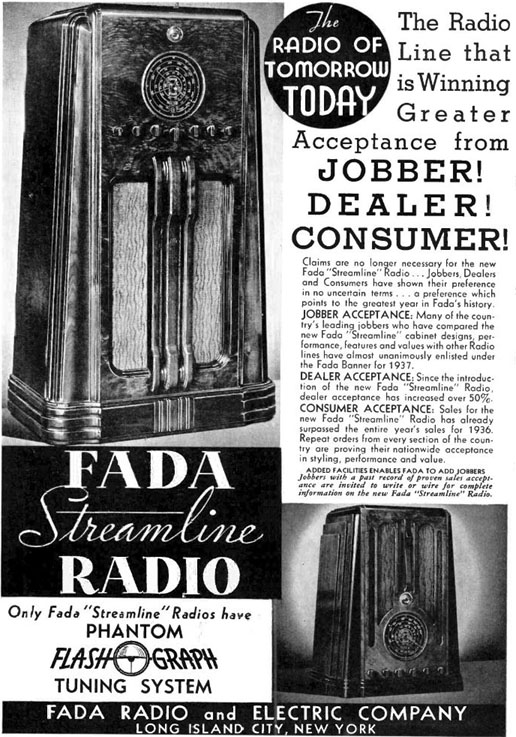
(July 1936 Radio Today)
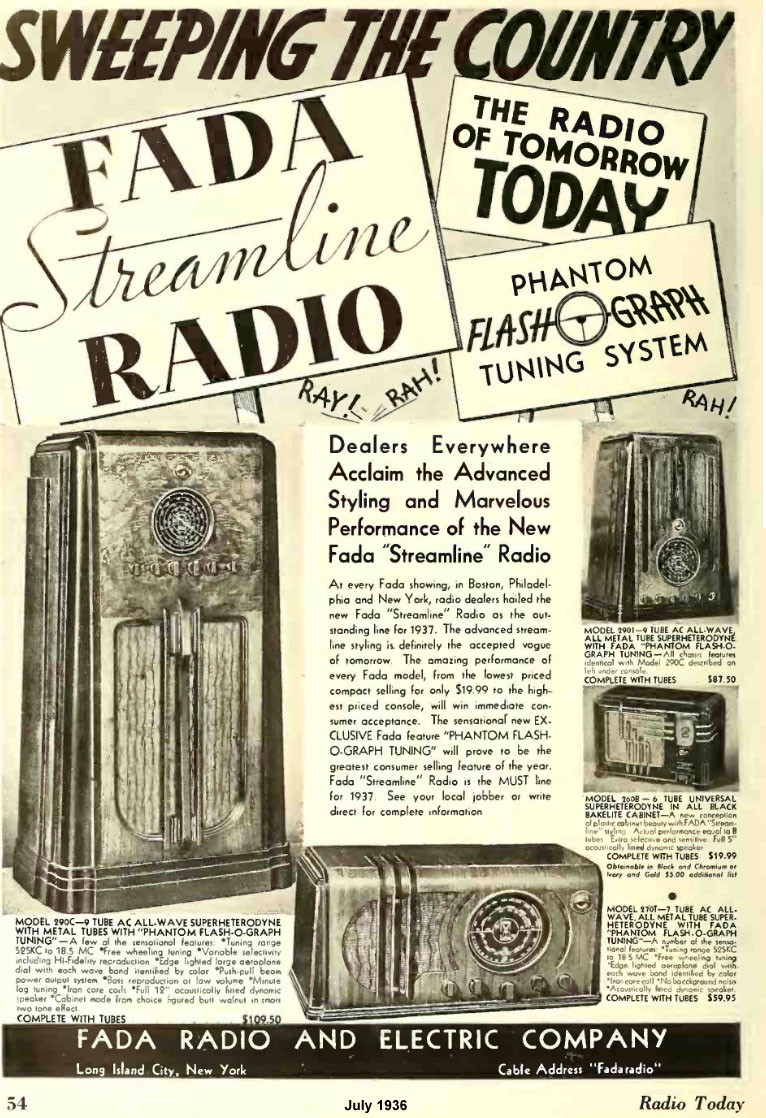
(Sept 1936 Radio Retailing)
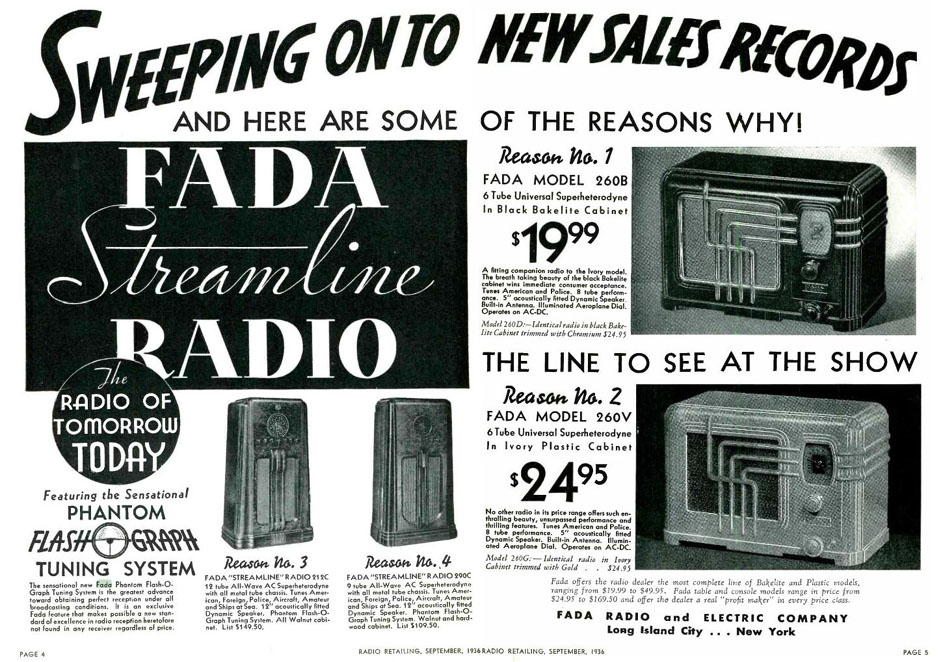
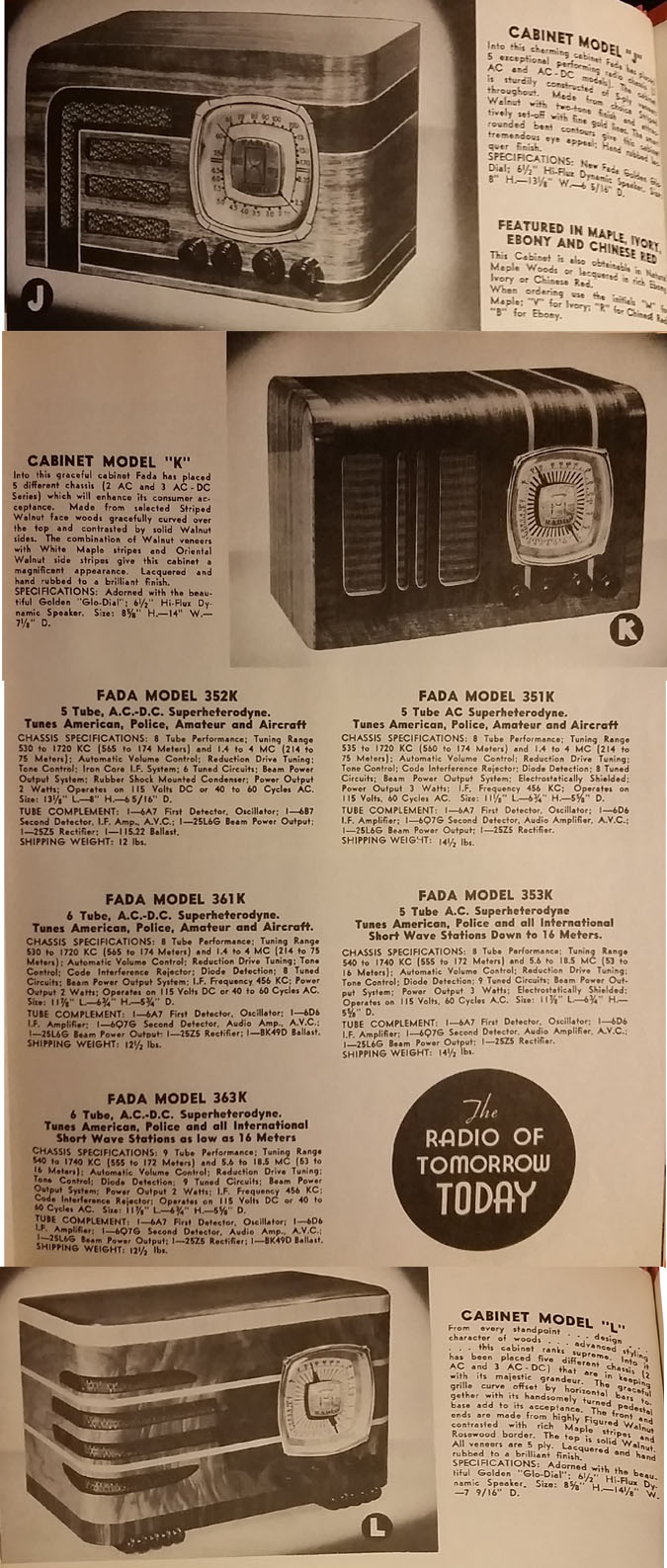
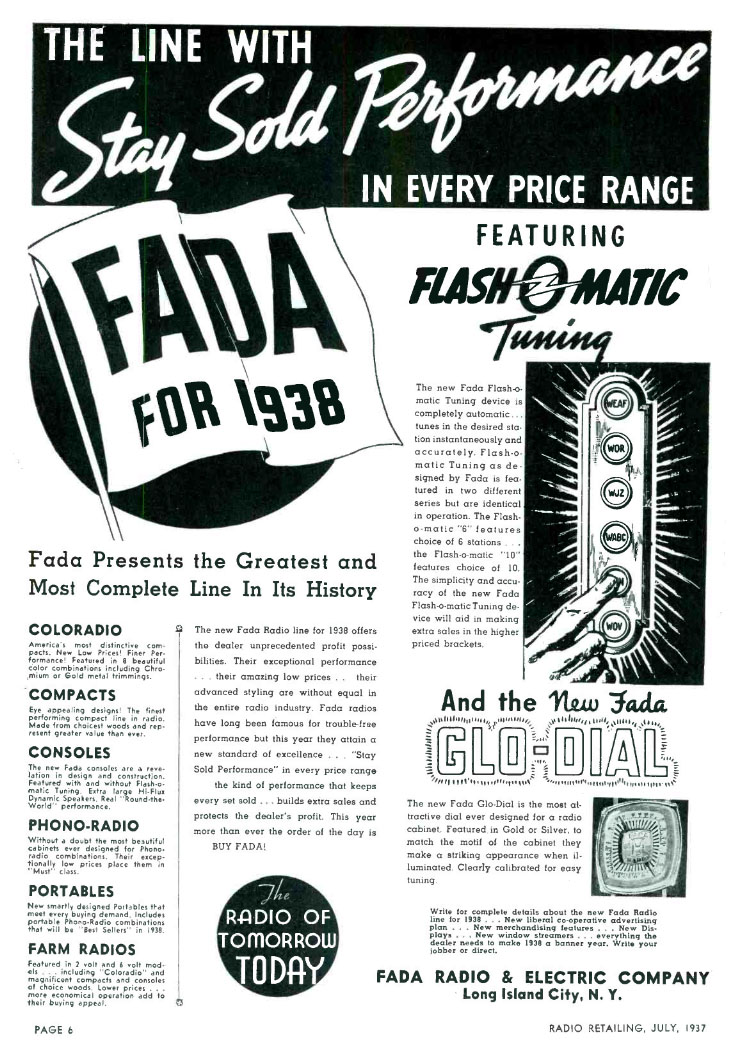
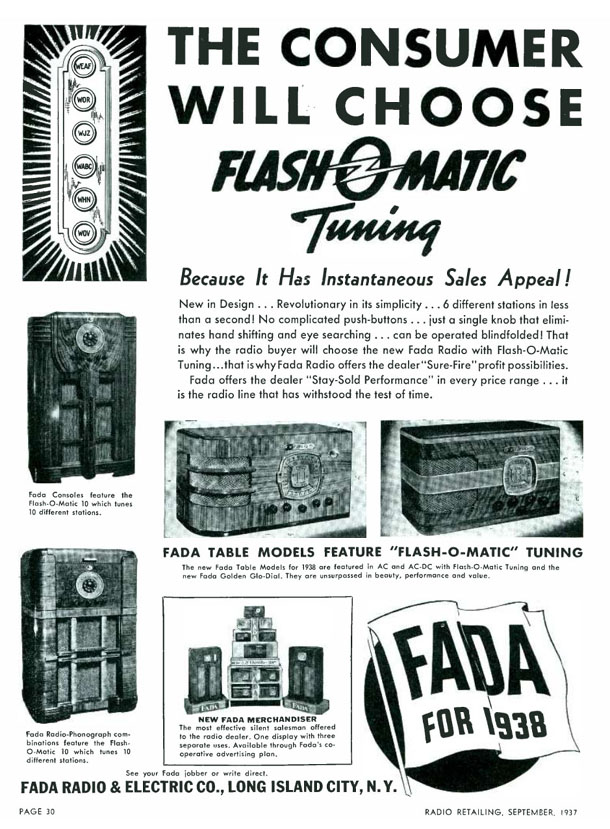
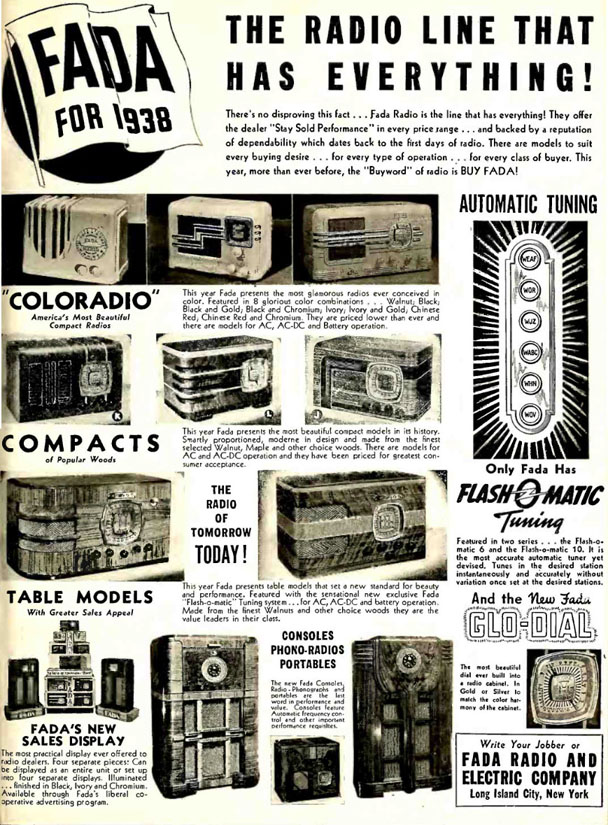
(1937)
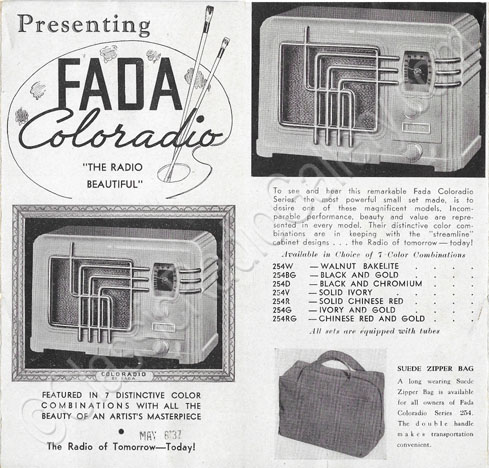
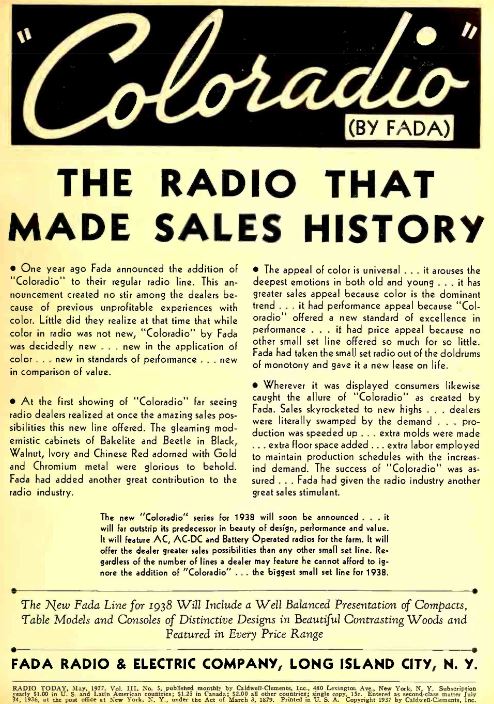
The catalin Fada L56 is found in the 1940 ad below, boasting of the use of green in the cabinet grille.
The Bakelite Corporation referred to all their different plastics as "Bakelite".
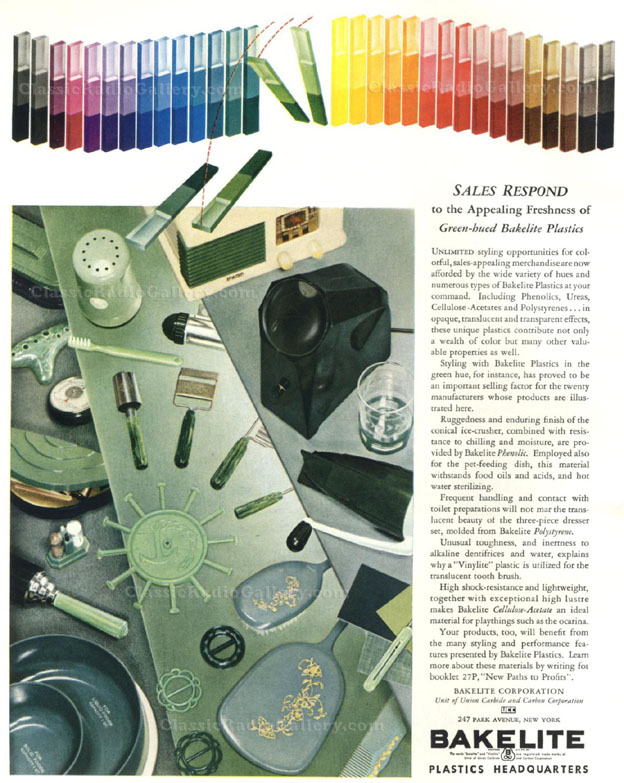
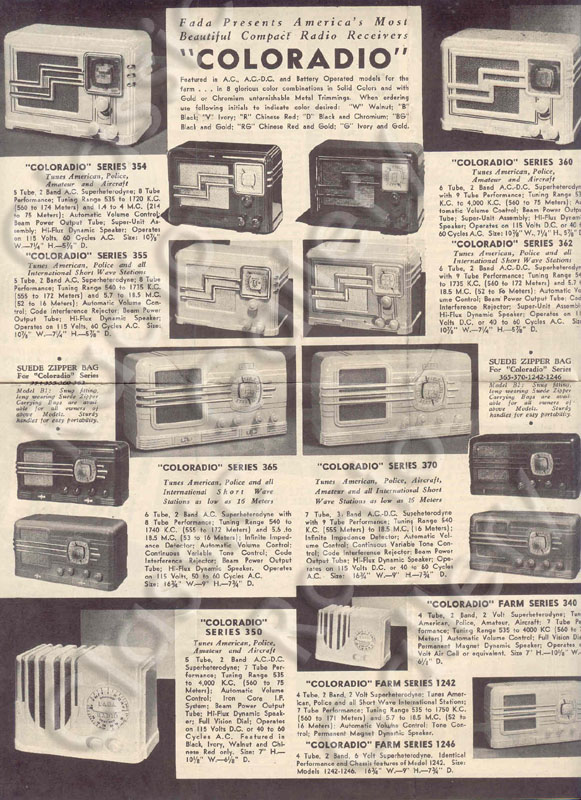
(some of the Dictograph Mystic Ear Silent Radio models)
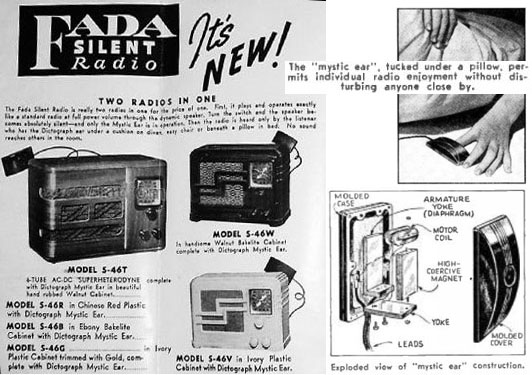
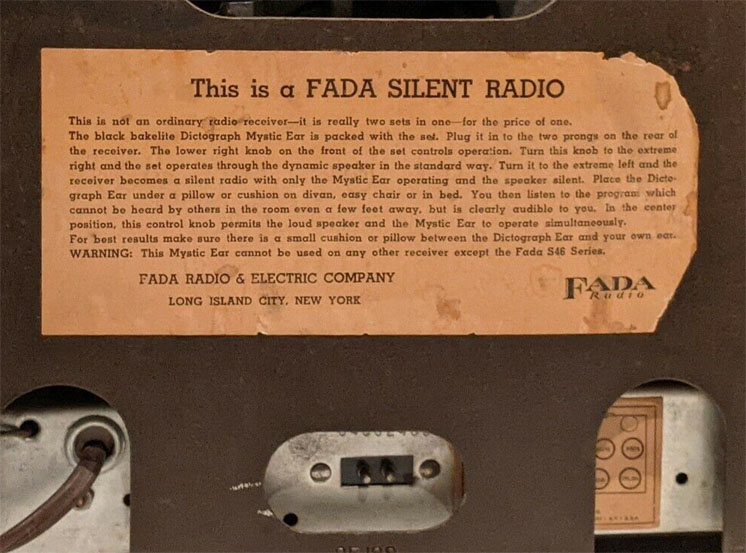
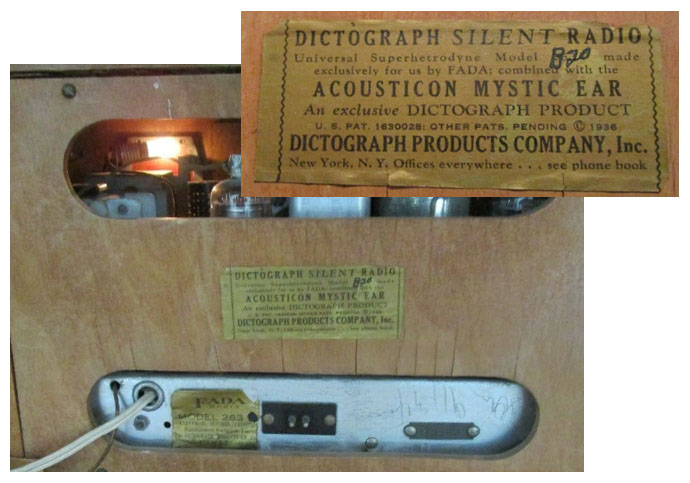
(1940)
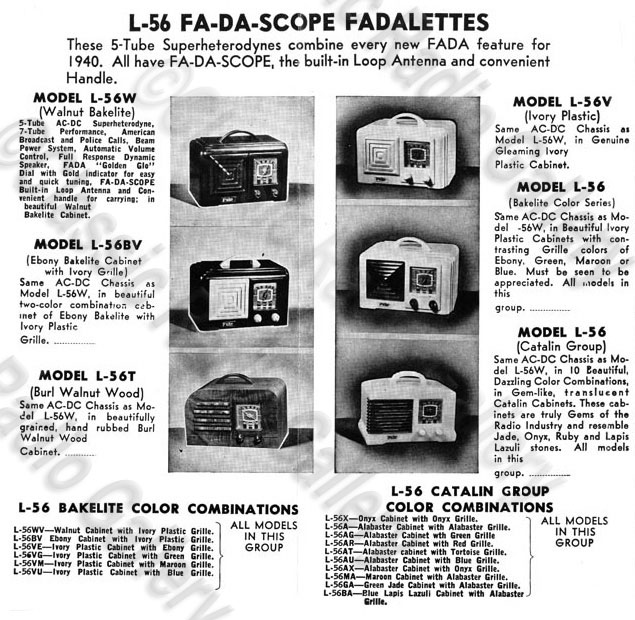
(1940)
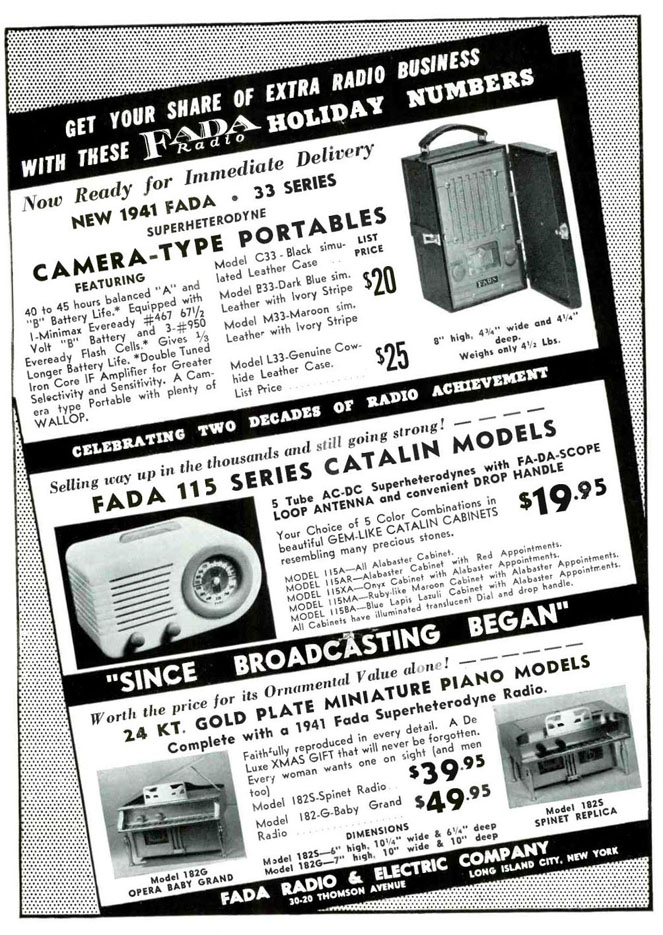
(1941)
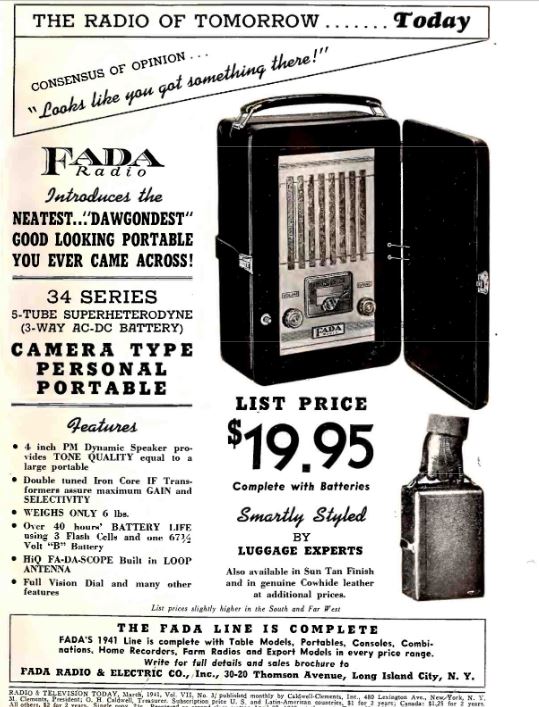
(1941)
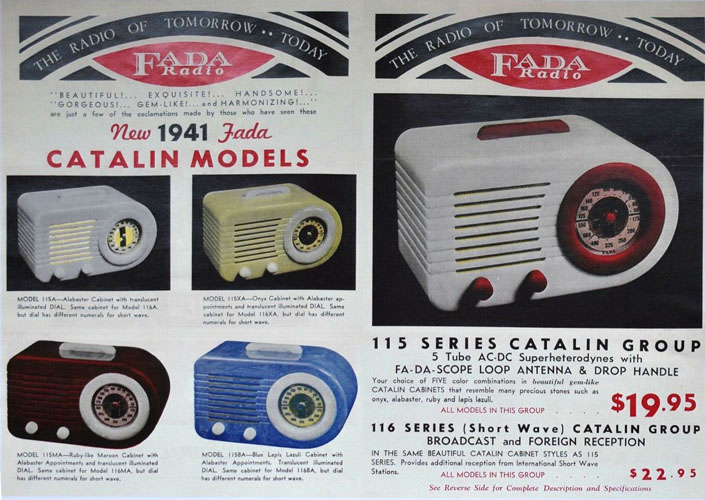
(Radio Retailing, MARCH 1943)
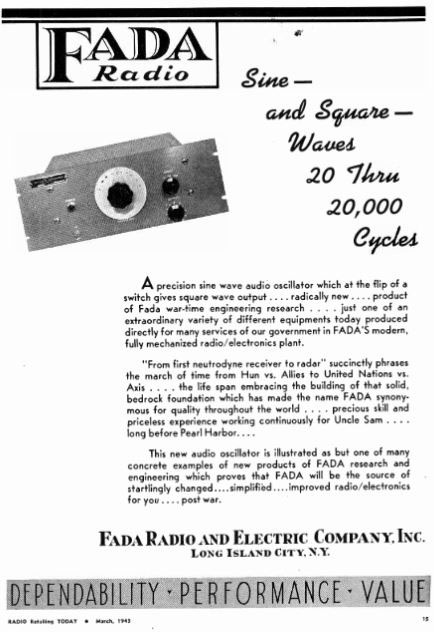
(Radio News, October 1945)
These two ads came out just as WWII was ending, including a message
that FADA is ready to make radios again for the public, waiting for the government's OK.
Both subtly include in the artwork, one of FADA's iconic models, the 652 "Temple".
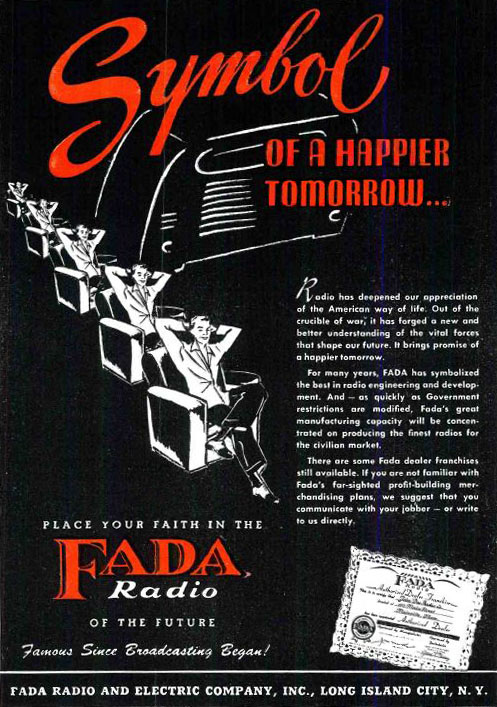
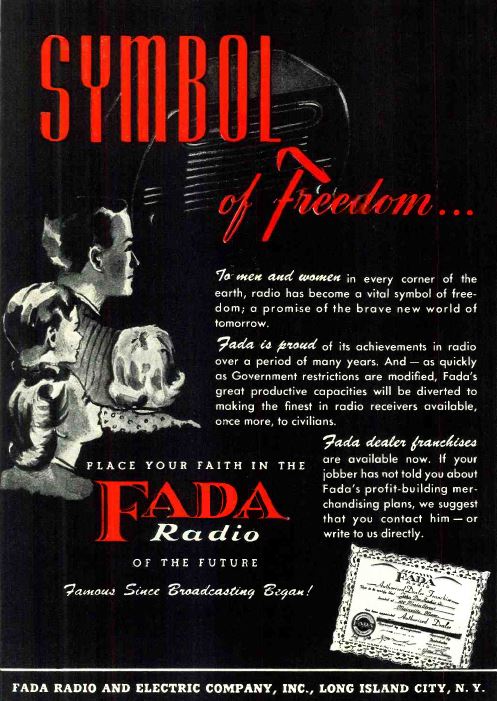
(Radio News, 1946)
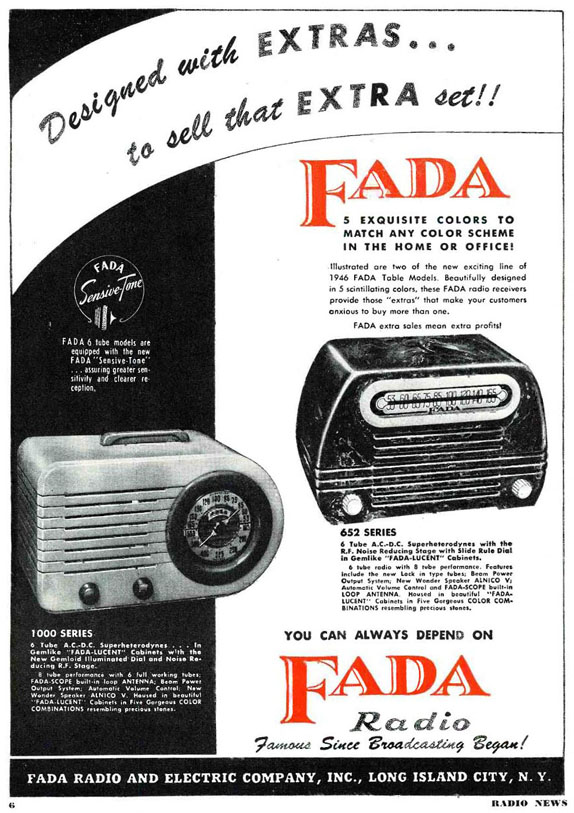
(1946)
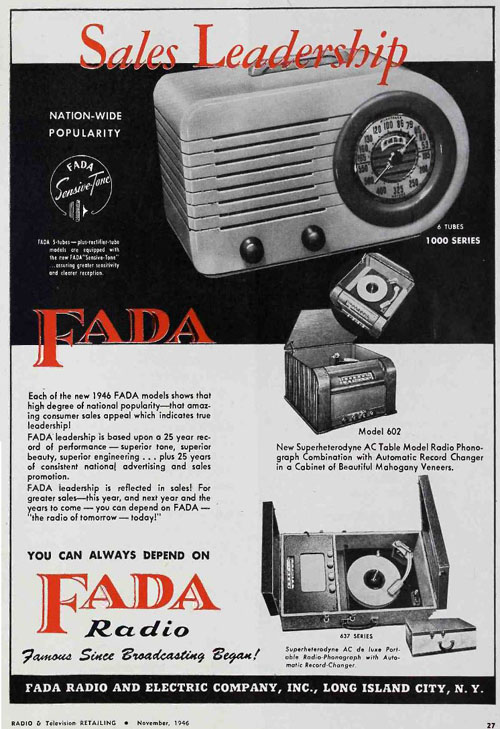
(1946)
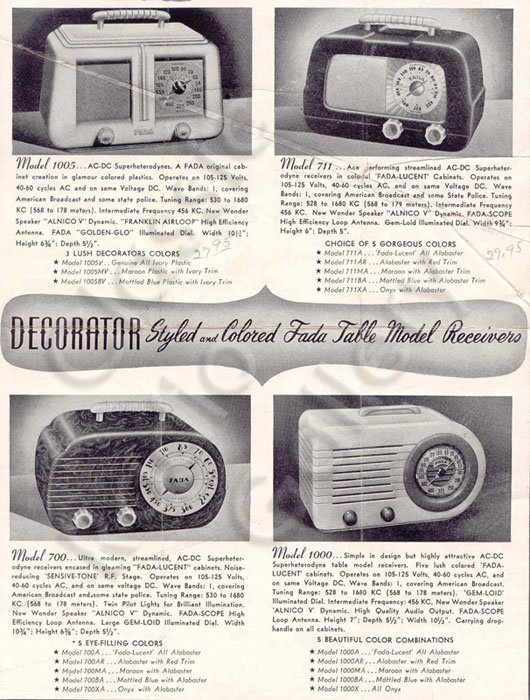
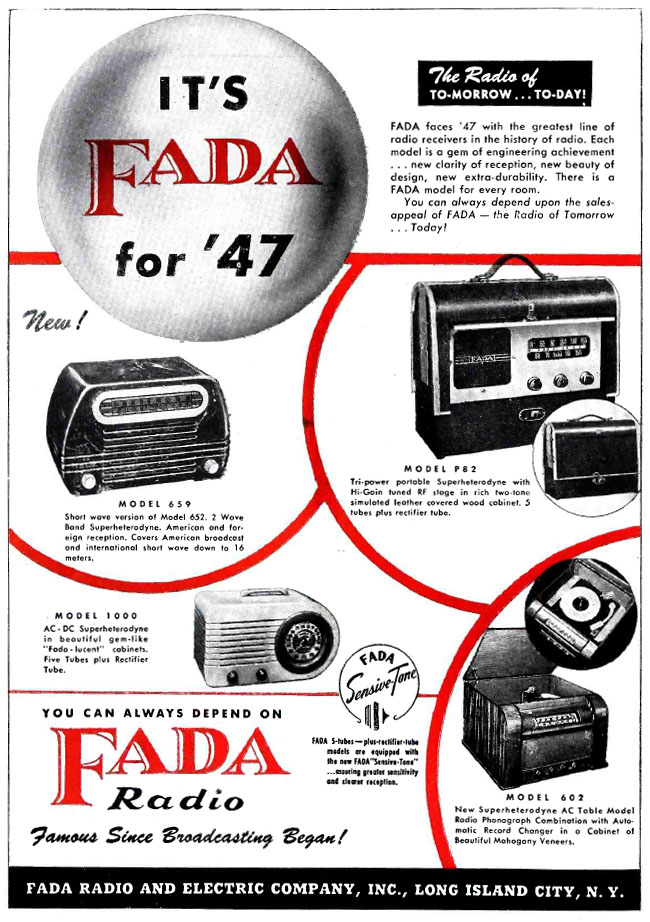
(Radio Retailing, November 1947, FADA's FM-only model 795
and catalin model 711 and the P80 portable)
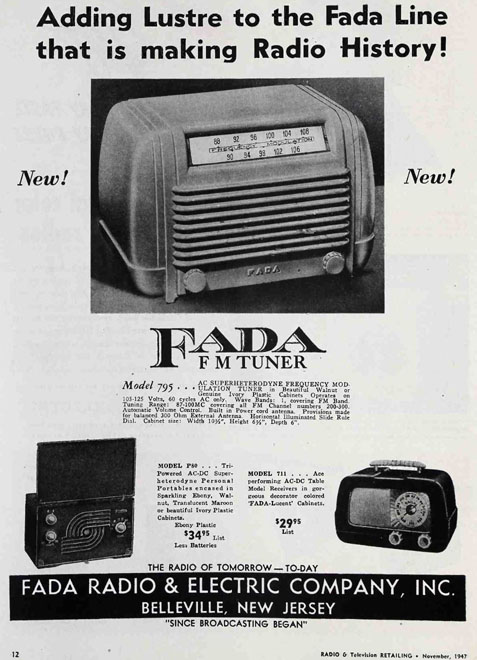

(Radio Retailing, 1948)
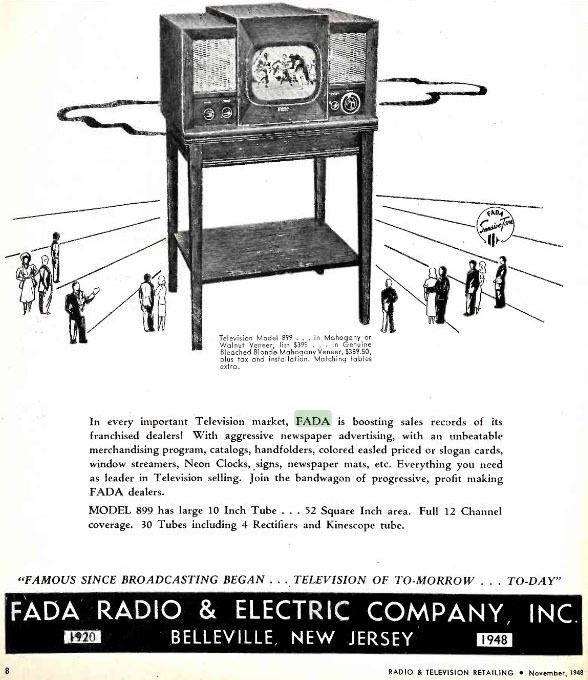
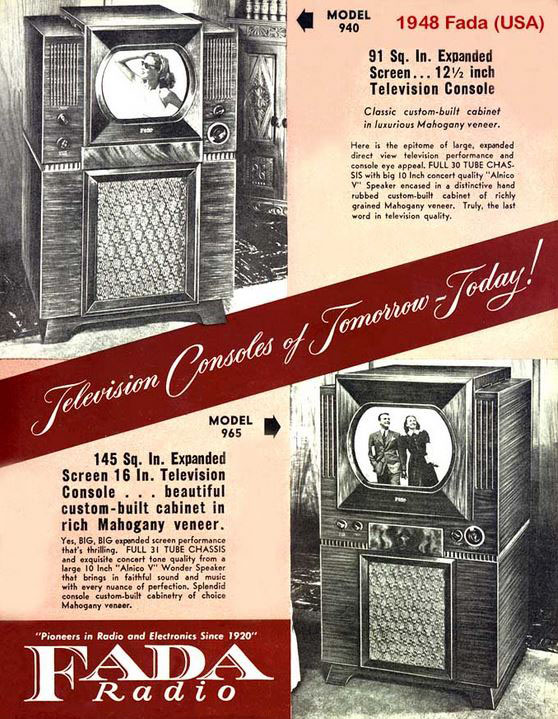
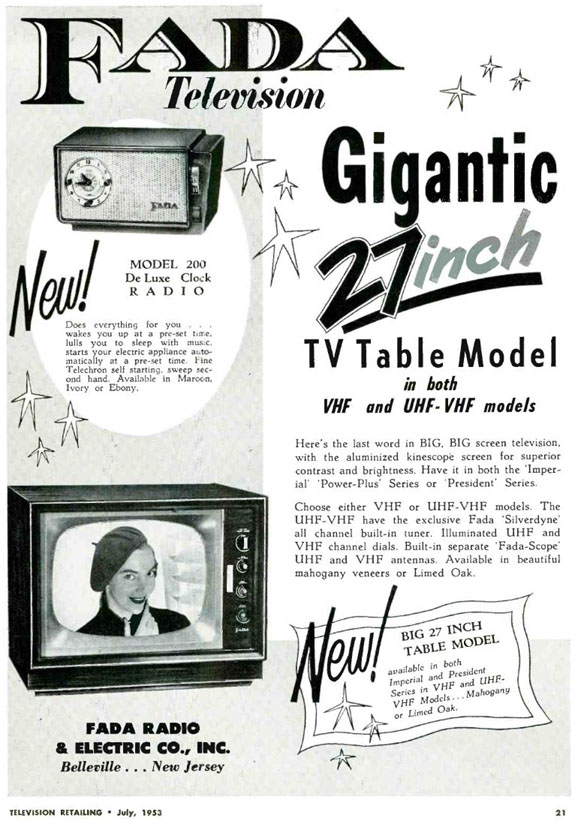


F.A.D. Andrea Inc. and Andrea Radio Corp. advertisements
(Andrea Radio, January 1938 Radio Retailing)
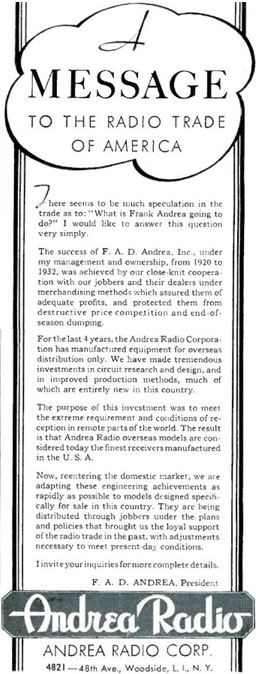
(Andrea Radio, Sept 1938 Radio Retailing)
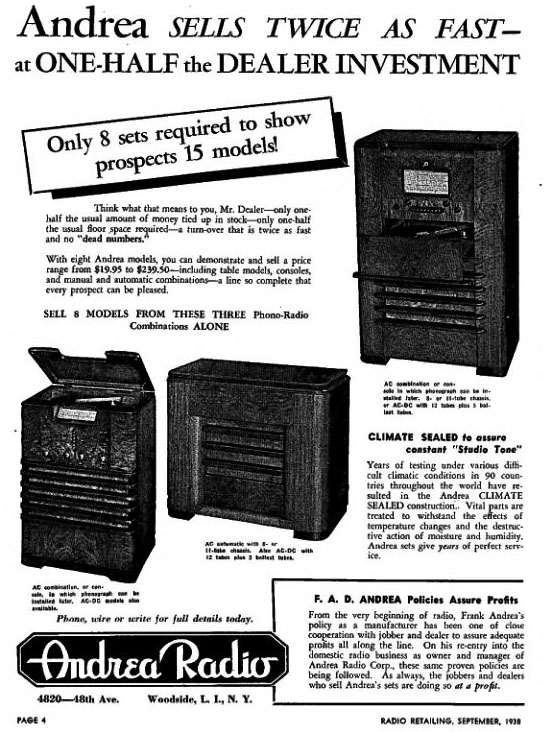
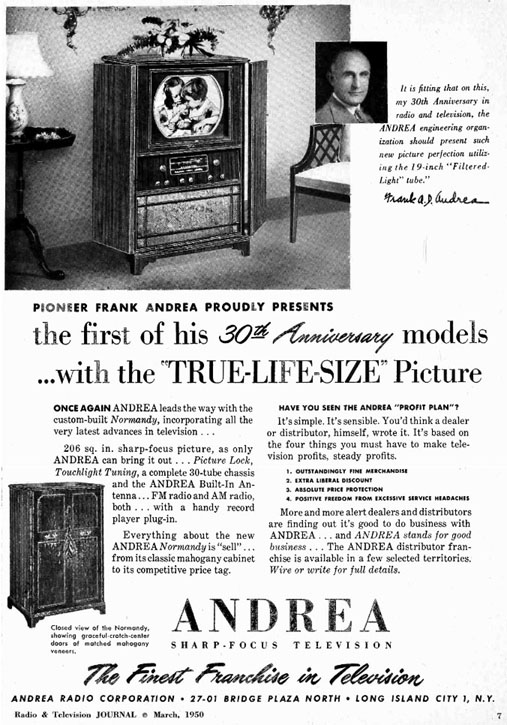
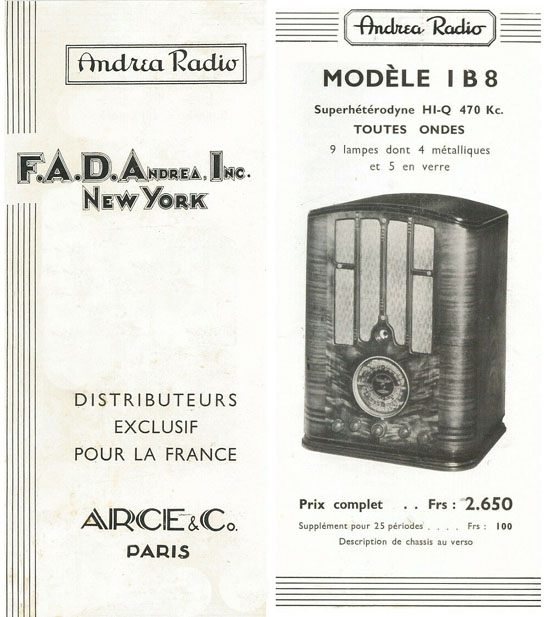
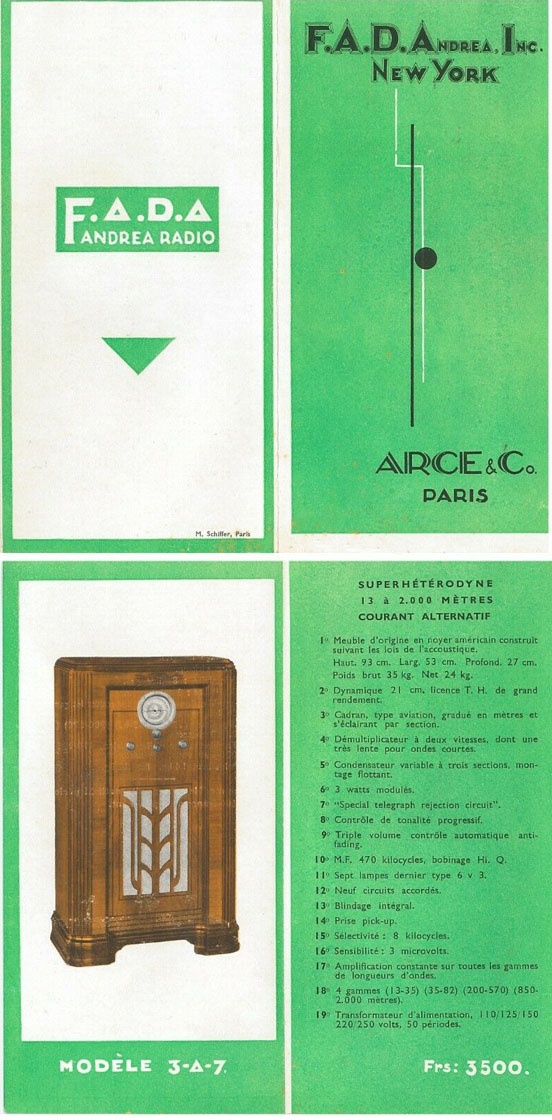
(1920s)
1927
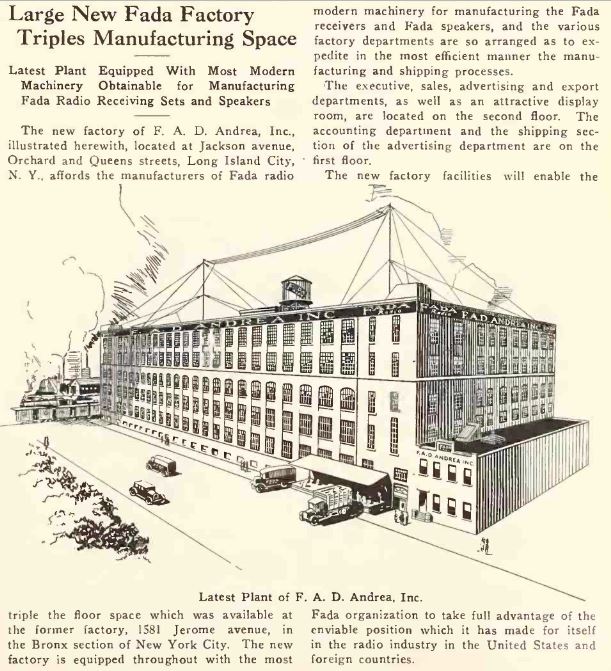
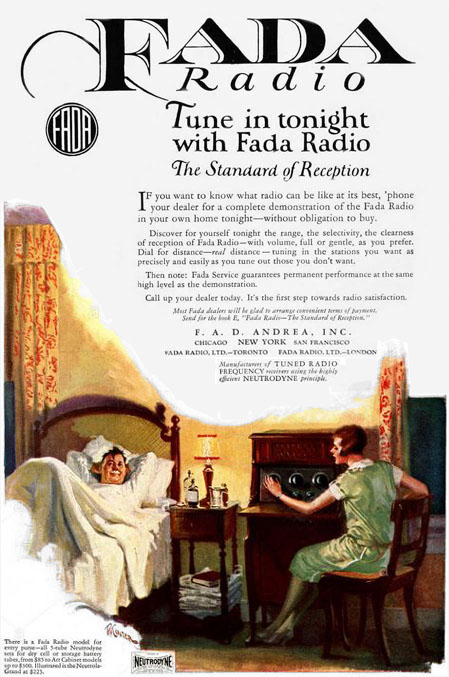
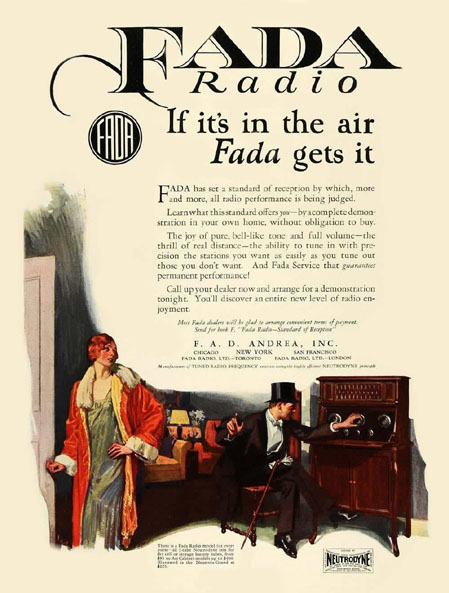
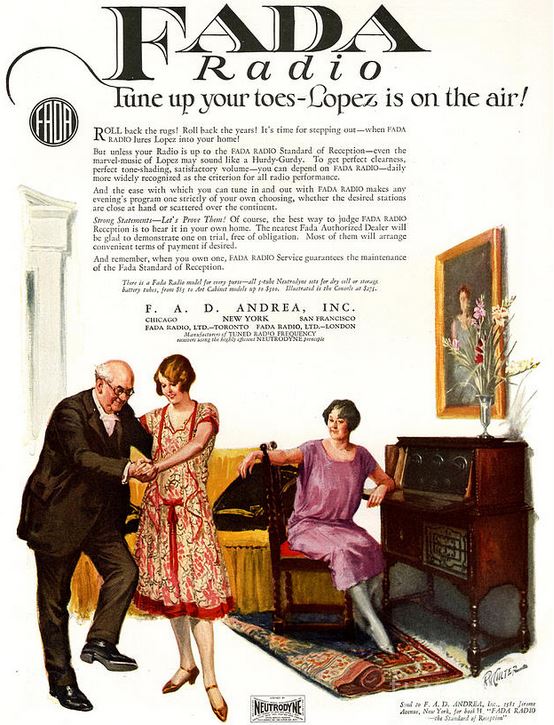
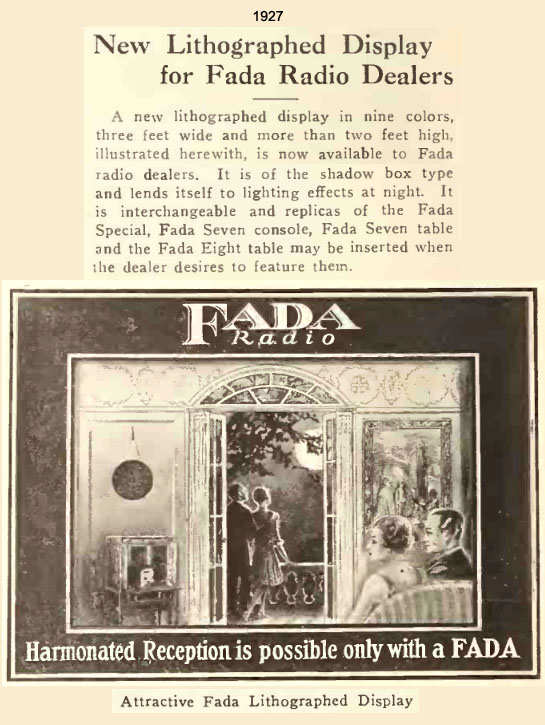
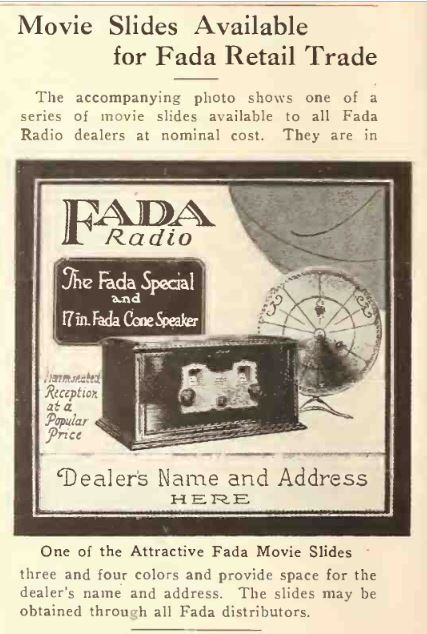
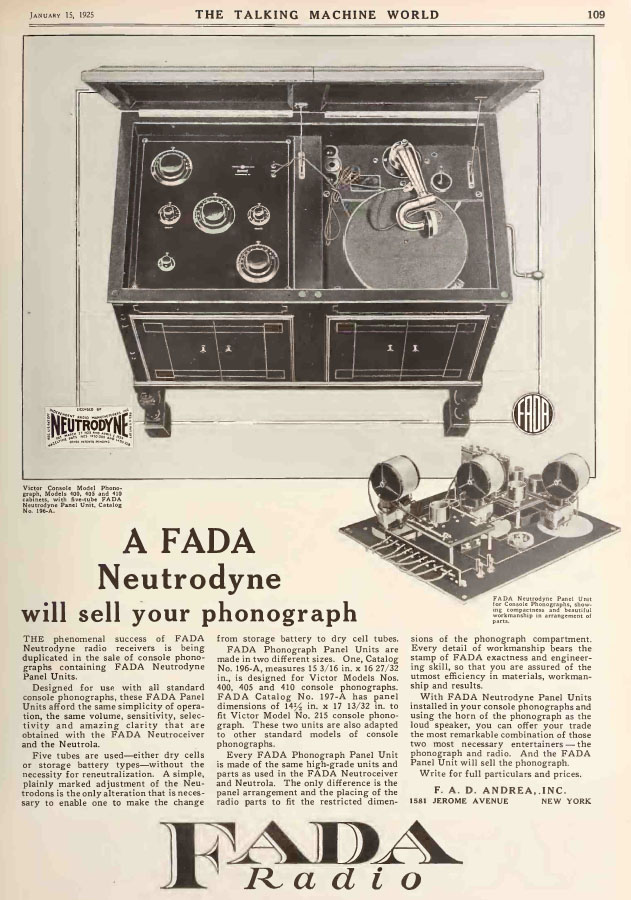
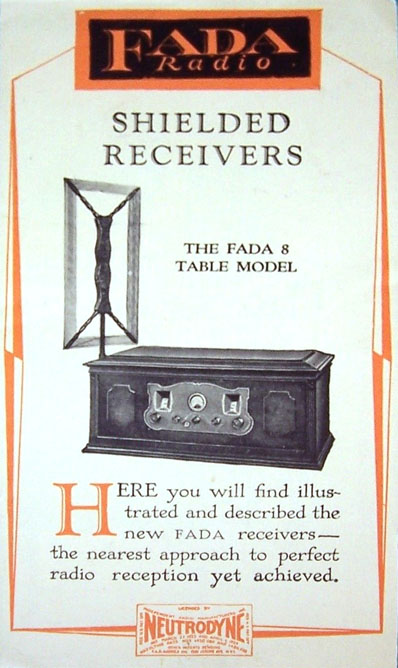
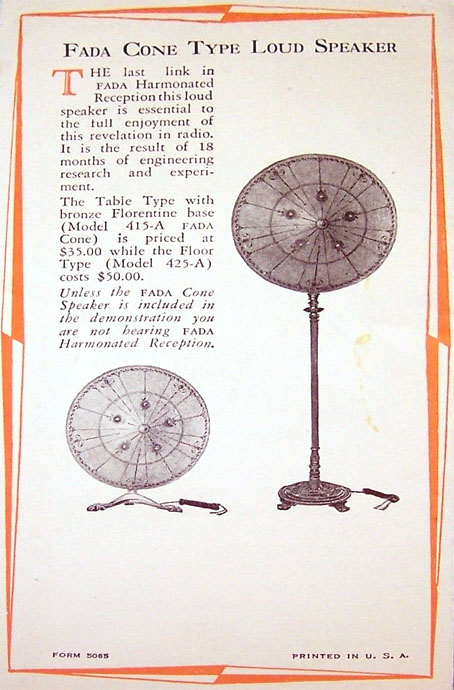

1932 - FADA Joins the appliance market!
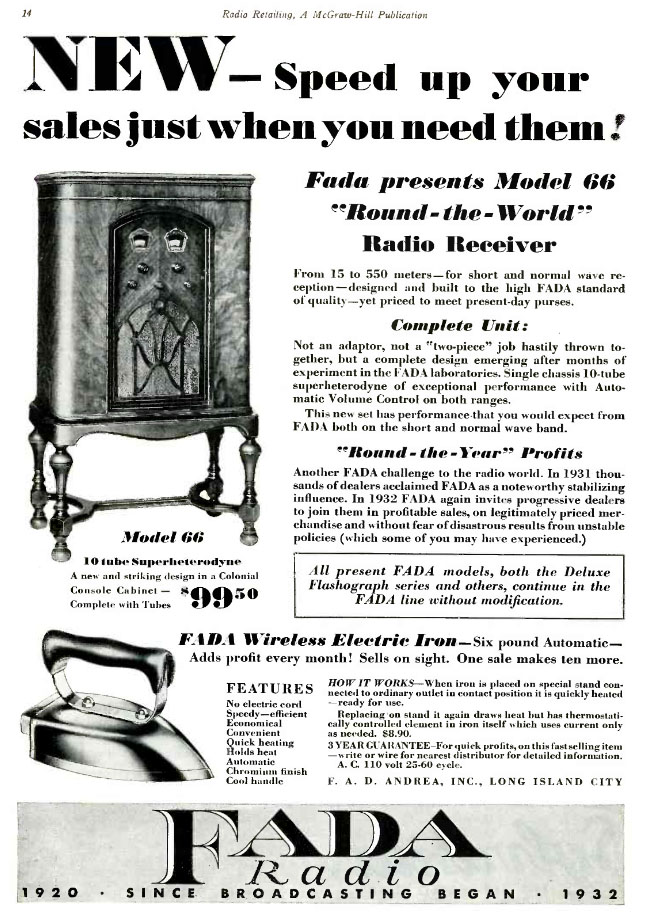
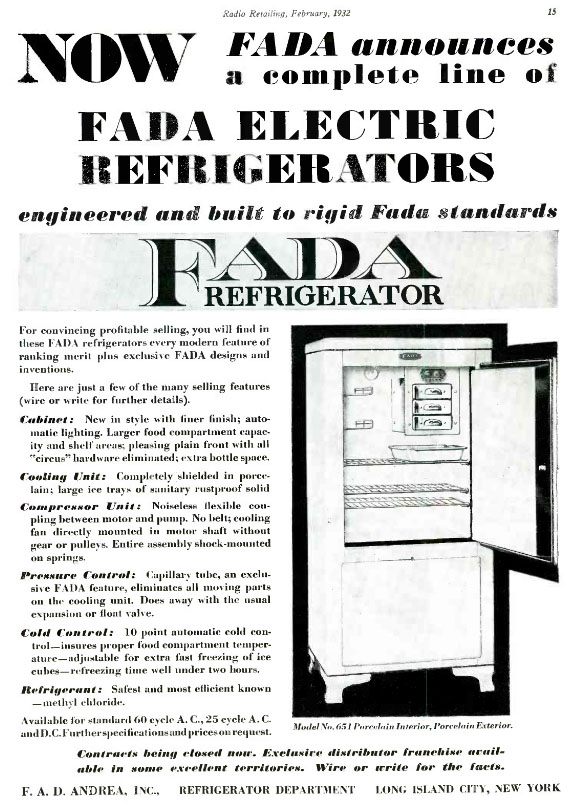
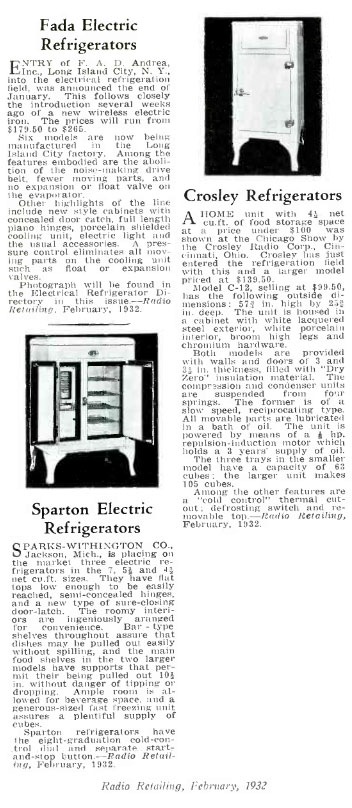
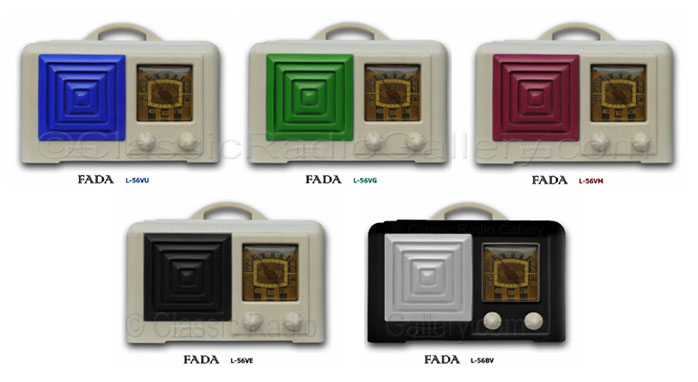
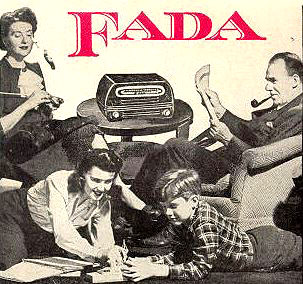
Before....
And after...
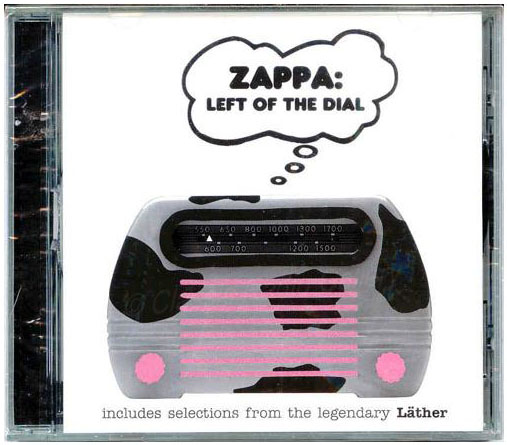
Frank Zappa 1996 promo-only CD release, "Left of the Dial"
featuring a wildly painted FADA model 652 "Temple" radio on the cover.
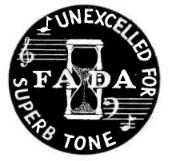
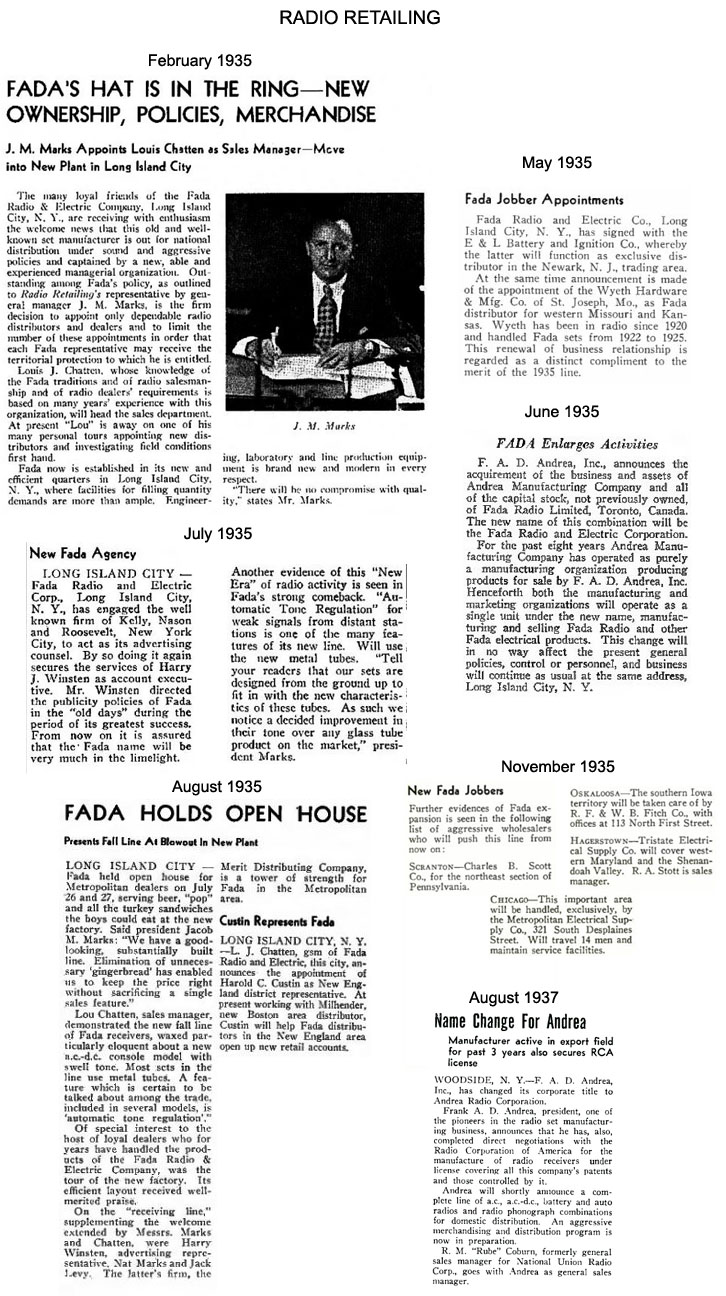
In early 1937, Marks released the private color coding
of resistor components used in the earlier FADA radios,
and began using the standard RMA color coding for components.
Radio Today, March 1937
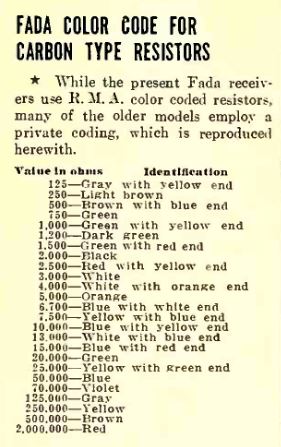
(Radio News, August 1941)
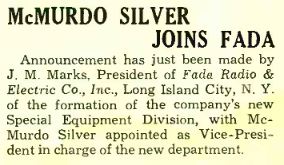
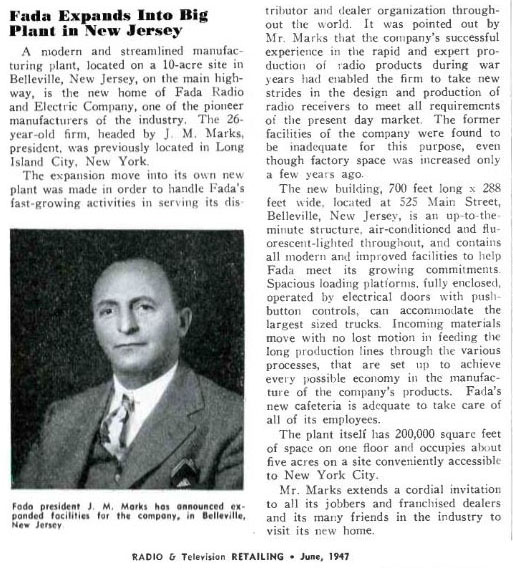

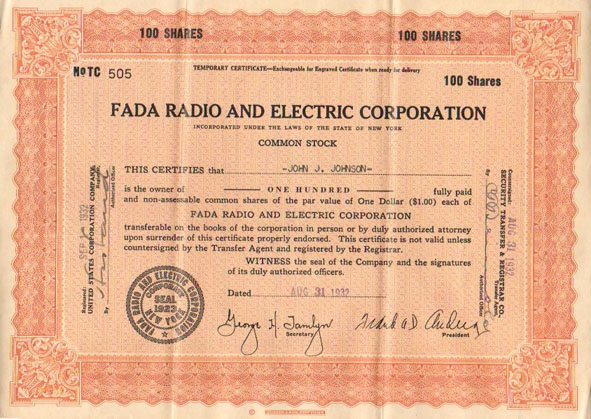
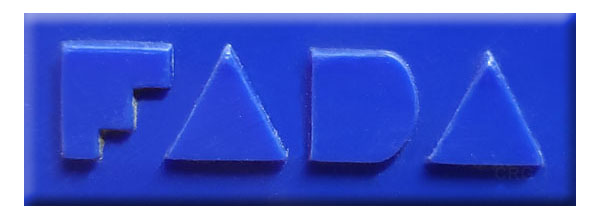

Fada 652 dial glass replacement available
CLICK for details
EMAIL:






